BoatNews.com

15 tips to get your boat out of the water without a fuss on a slipway
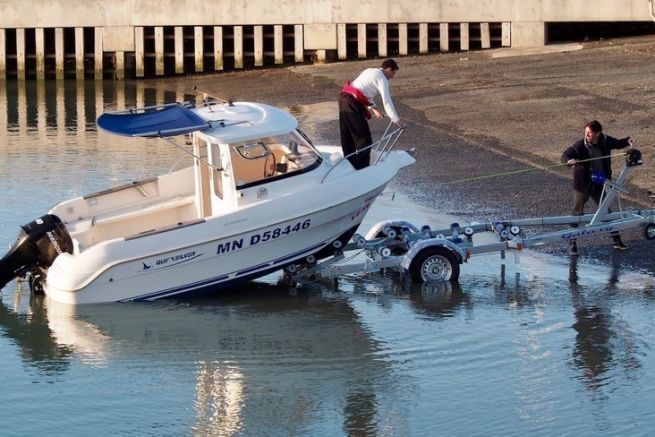
After a beautiful day of sailing, the boat has to return to its trailer. The maneuver is not exactly the opposite of the launch at the beginning of the day. So here are a few tips.
A successful exit from the water at the end of a day at sea can be anticipated. Even if you've been sailing for a long time, it's late, the crew is tired and you have other things on your mind, take the precaution of looking around. The hold you used safely that morning may have changed with the tide . Mud, seaweed and crowds can make things very difficult.
Prepare car and trailer
- When you pick up your car , take the precaution of letting the engine warm up for a few moments. You'll be asking for a lot of effort to get it back up!
- If your trailer is articulated, unbolt the bolt that allows you to "break" the drawbar. This tilting allows you to lower the first roller without backing up too much, and therefore without submerging the axle.
- Back your hitch into place and make sure the winch cable is clear, sufficiently unwound and the winch pawl is in place for the lift.
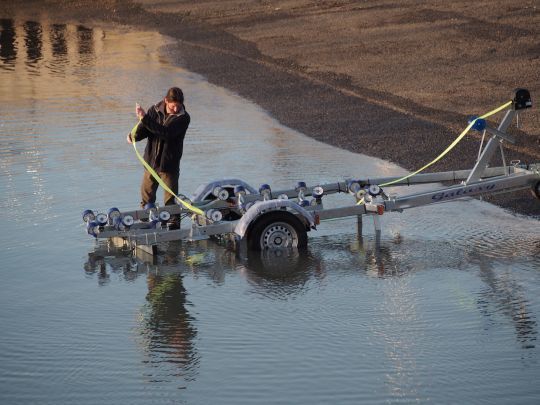
Mount the boat on the trailer without a hitch
- When the boat comes in, stow the hook and center the nose of the boat on the first roller.
- If the depth allows, the crew member on board will remain engaged in forward gear in order to keep the bow in place.
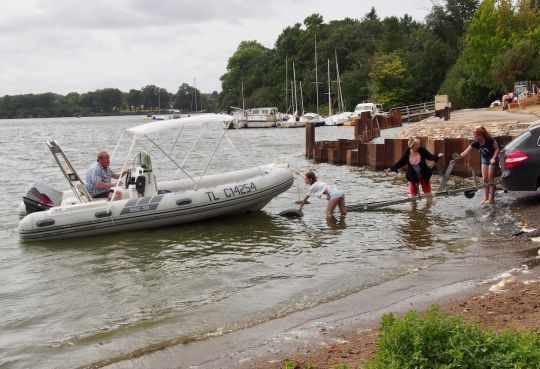
- Winch to tension the cable, until the boat climbs over the first few rollers. The person on board then turns off the motor and pulls it up.
- As you go up the hill, make sure the boat is aligned and riding well on the trailer rollers.
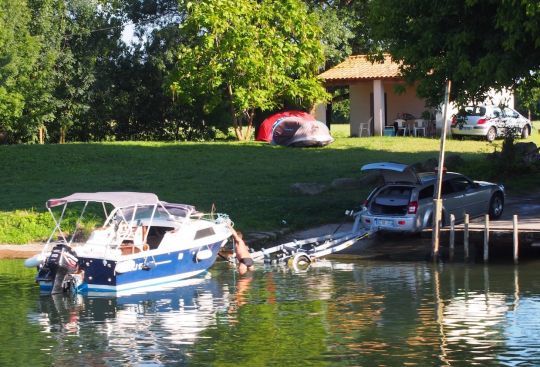
- With boats that have an embryonic keel , it may be necessary to have a helper on either side of the boat to hold the boat in balance as it begins to rise.
- If there is a little water in the boat , we will open the bung as soon as possible, which will allow to empty it quickly thanks to the slope.
- Once the boat is wedged against the bow stop, clear the hold: once on the flat, you will have plenty of time to stow what needs to be stowed and prepare your hitch for the road.
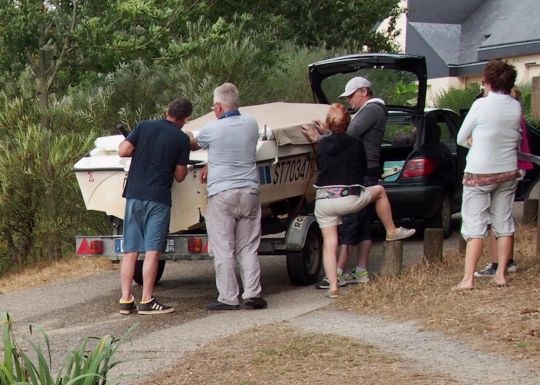
Take the time to prepare the boat for the road
- Disconnect the fuel supply and close the air vent. Secure the key and kill switch and secure the engine in the transport position. Take in everything that could fly away: cushions, vests, etc.
- The boat should be carefully strapped in place, but without exaggerating the tension so as not to deform the hull.
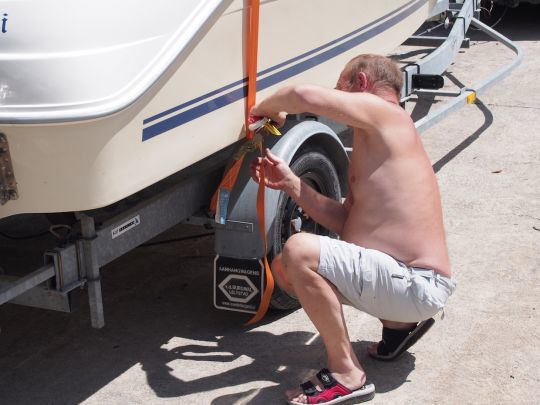
- On the trailer side, we will put the lights back in place and we will not fail to check their good functioning.
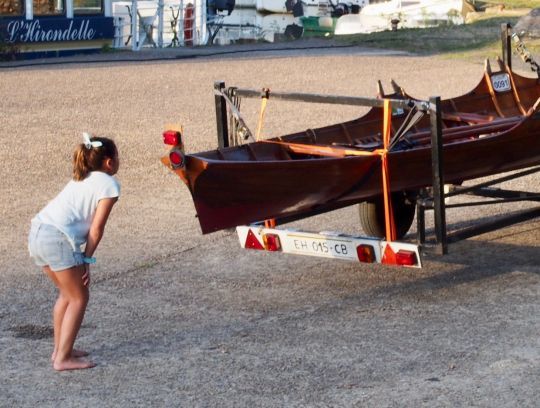
- Don't forget, of course, to re-clamp the tilting drawbar and check that the jockey wheel is locked in the upper position and does not risk loosening while driving.
- Stop at a fresh water source to rinse the trailer of salt, paying special attention to the wheels and hubs.

- EXPLORE Random Article
- Happiness Hub
How to Take a Large Boat Out of the Water
Last Updated: February 20, 2021
wikiHow is a “wiki,” similar to Wikipedia, which means that many of our articles are co-written by multiple authors. To create this article, volunteer authors worked to edit and improve it over time. This article has been viewed 14,543 times.
Taking a large boat or yacht out of the water is much more than just pulling up to a ramp and towing it back to your house. It involves heavy machinery, and it takes patience and a lot of care. This article is meant for marina/yacht club workers or anyone with some knowledge of boating who is interested in the process.
This wikiHow article will teach you step by step how to take a large boat out of the water using a marine travel lift (a large machine used to take boats in/out of the water), transport the boat to a viable spot, and block it up on land. Work carefully and check your surroundings and equipment after every step.
Taking the Boat out of the Water

- There are four wheels on the lift; the back two are the wheels that control the turning.
- Every travel lift has two straps (one in the back and one in the front) that can raise and lower using 3 levers. The point of the straps are to lift/lower a boat while giving it support.

- The two levers on the left control the back strap and the horizontal lever 3rd from the left controls the front strap.
- To lower the back, you have to push the two levers upward (they move the straps opposite of the direction of the levers).
- Lower the front by pushing the third lever from the left down (it moves the strap the same direction as the lever).
- Lower the straps until they are about 3 feet underwater and the lowest point.

- The boat well is an inlet of water where boats are put in/taken out of the water. The travel lift is located above the well.

- Sling marks are there to make sure weight is distributed when the boat is being raised; if not the boat could slide back or forward off of the straps.

- The left two levers go down and the third lever from the left goes up.
- Make sure to pull the straps up at the same time.
- Since the front and back straps of the travel lift are independent of each other, you can move one or the other to straighten the boat. (For example, if the front of the boat is leaning down, pull up the front strap until even.)
Putting the Boat onto a Trailer

- Put the trailer right behind the travel lift and make sure it is straight.
- Add a wooden block to the back support beam of the trailer.
- Stack 3 pieces of wood and one piece of plywood to the middle support beam of the trailer.
- Make sure that the wood is secure because this will hold most of the weight of the boat on the trailer (about 95%).

- The travel lift will start off on wheel tracks right above the boat well; it should be moved backwards just past the tracks onto the cement.
- Make sure to move the travel lift slowly so that the boat does not move back and forth too much.

- Use an industrial power washer such as the one in the picture.
- Make sure not to get too close when spraying. It could cause the paint to be washed off of the boat.
- If there doesn't seem to be a plug in the back, don't worry. Some boats drain in the front and the boats that do this have no plug.
- 5 Move the trailer under the boat. Once the boat is over land, the trailer can be moved so that the middle of the trailer is lined up with the middle of the boat.

- Make sure the stands are tightened after the boat is placed on the wood (the stands are only meant to hold about 5% of the weight of the boat).
- Make sure the platforms on the support stands are flat against the boat.
Blocking the Boat
- Make sure that it is on level ground.
- This is where the boat will be throughout winter so make sure it is a spot that you're comfortable with. It would be difficult to move it during winter.
- Once the trailer is moved, the straps of the travel lift can be put back together and the travel lift can be moved back onto the tracks over the well.

- Stack as many cinder blocks that will fit.
- Make three stacks: one in the middle and two in the corners of the stern.
- After the cinder blocks are stacked, stack wood until there is only an inch or so in between the boat and the wood.
- Add a thin piece of plywood to alleviate pressure between the boat and the wood.

- The weight of the stern should be completely on the blocks while the weight of the front is still on the trailer.
- By moving the trailer back while keeping the boat up, this makes room to put blocks in the front of the boat.

- Place two stacks of cinder blocks in the middle of the boat (lengthwise) and one stack under the bow of the boat.
- As you did before, place wood on the blocks until there is only an inch of room.
- Make sure the blocks are centered with the boat width wise.

- Once the boat is completely on the blocks, all of the support stands on the trailer should be lowered all the way so that they don't hit the hull (bottom of the boat) when moving the trailer.
- 7 Move the trailer. Once the boat is on all of the blocks, the trailer can be moved as it will not be needed again.

- Depending on the way the boat is blocked, 2-4 jack-stands will be needed (in this case, since there is 3 stacks of blocks under the stern, only 2 are needed).
- Place the stands near the center of the boat, one on each side and tighten them against the hull of the boat.
- The platforms of the jacks should be near the edge of the hull so that the weight is distributed.
- Keep the platforms of the stands flat against the hull (sometimes wood is needed to be placed in between the hull and jack-stands).

Expert Q&A
- Make sure to check your surroundings when operating the machinery; people should not be within 15 feet of the machines and should be within your sight. Thanks Helpful 0 Not Helpful 0
- Walk around the boat after each step to make sure everything is secure and safe. Thanks Helpful 0 Not Helpful 0
- Don't rush. Caution should be used and rushing everything will make it much more dangerous. Thanks Helpful 0 Not Helpful 0
- Use plenty of caution operating the travel lift. It is a large machine that is capable of killing or severely injuring those operating it and those around it. Thanks Helpful 0 Not Helpful 0
- Never get too comfortable under a boat. Always be on your toes and ready to move in the rare occasion that the boat could fall. Thanks Helpful 0 Not Helpful 0
Things You'll Need
- Marine travel lift
- Transporting trailer
- Cinder blocks
- Crescent wrench
You Might Also Like

About this article
Did this article help you.

- About wikiHow
- Terms of Use
- Privacy Policy
- Do Not Sell or Share My Info
- Not Selling Info

Service Locator
- Angler Endorsement
- Boat Towing Coverage
- Mechanical Breakdown
- Insurance Requirements in Mexico
- Agreed Hull Value
- Actual Cash Value
- Liability Only
- Insurance Payment Options
- Claims Information
- Towing Service Agreement
- Membership Plans
- Boat Show Tickets
- BoatUS Boats For Sale
- Membership Payment Options
- Consumer Affairs
- Boat Documentation Requirements
- Installation Instructions
- Shipping & Handling Information
- Contact Boat Lettering
- End User Agreement
- Frequently Asked Questions
- Vessel Documentation
- BoatUS Foundation
- Government Affairs
- Powercruisers
- Buying & Selling Advice
- Maintenance
- Tow Vehicles
- Make & Create
- Makeovers & Refitting
- Accessories
- Electronics
- Skills, Tips, Tools
- Spring Preparation
- Winterization
- Boaters’ Rights
- Environment & Clean Water
- Boat Safety
- Navigational Hazards
- Personal Safety
- Batteries & Onboard Power
- Motors, Engines, Propulsion
- Books & Movies
- Cockpit Confessions
- Communication & Etiquette
- Contests & Sweepstakes
- Colleges & Tech Schools
- Food, Drink, Entertainment
- New To Boating
- Travel & Destinations
- Watersports
- Anchors & Anchoring
- Boat Handling
- ← How-To DIY
Boat Haul Out
Advertisement
For many, an annual haulout is the end of the boating season. Plan it all out first so it doesn't make you crazy.
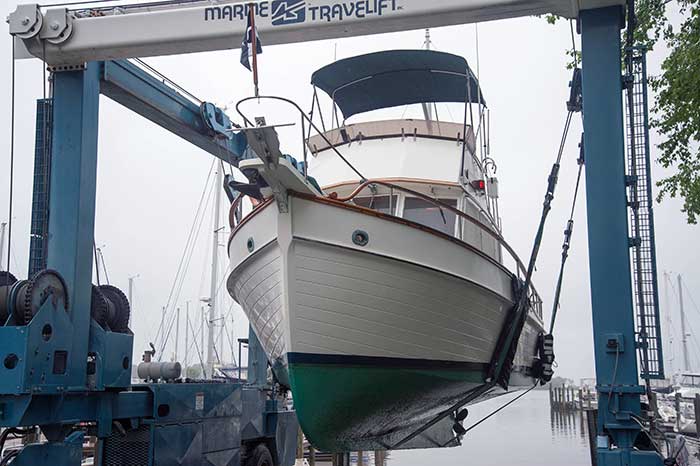
Spring and fall are the busiest seasons for hauling. Make sure to plan ahead with your marina to ensure they can fit you into their schedule.
Many boats will have to be hauled by a boatyard or marina at some point. You might think that all you have to do is show up with your boat to be plucked from the water and deposited safely in the yard, but not so fast. Forward planning ensures things go smoothly for you, your boat, and the yard.
Make Arrangements
If your marina has a travel hoist, hauling at your home port is often the most straightforward option: Your boat will already be at the haulout location, and the yard staff may be familiar with it. If it's not possible to haul at your marina, there are specific logistical considerations, not least that you will have to move your boat and deliver it to the yard at the appointed time.
Once you've decided where your boat will be hauled, you need to decide when. Give the yard as much notice as possible: Don't wait until the day before and expect them to be able to accommodate you. Keep in mind that the yard's busy season is during late fall when boats are pulled for winter storage and then again in the spring when boats are relaunched. Schedule accordingly. Jay Leszynski, owner of Merri-Mar Yacht Basin in Newburyport, Massachusetts agrees, "Spring and fall are our busiest times by far. Not only do we have a lot of boats to move, but we have to plan where to put them once they come ashore. Letting us know your plans early helps us a lot".
Cost And Scope
Check with the yard on how much you will be charged for haulout service. Most yards charge by the foot and will often have a minimum fee. In many cases, the cost also includes a relaunch, but you need to be sure. Some yards have haulout contracts. If yours does, read it carefully to know what is — or is not — included. If your yard doesn't have a contract, ask questions and take notes so you are clear about the arrangements.
If you expect your boat to be out for a fairly short time for some maintenance, such as a bottom job, anode change, thru-hull or transducer installation, tell the yard this. If your boat is buried at the back of the lot with other boats parked in front, you may not be able to launch when you want. If you are storing ashore for the winter months, let the yard know when you would like to be launched in the spring, as this will have some bearing on where they place your boat.
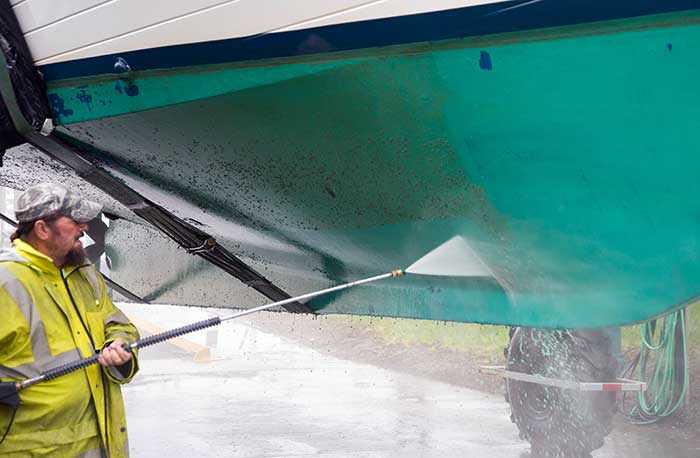
Pressure washing the boat is often included in the cost of the haulout.
If you want the yard to do some work on your boat while it's out of the water, talk to them about it up front. If you forget to tell them, it may delay things if they don't have you on the schedule or they don't have the necessary parts in stock.
If you plan to do some or all of the work yourself, talk to the yard about this, too. They may have policies about what you can and can't do yourself. Many marinas prohibit owners from working on their boats, citing insurance or environmental reasons, which is sometimes merely a way of getting more work for their crew. Flexible marinas may allow you to do your own work provided you comply with all rules, such as no hull sanding without a vacuum and laying ground cover under the boat to catch hazards like spilled bottom paint.
Lifting Your Baby
On the actual day of the haul, plan to be there if you can. You'll be able to take a look at just how fouled the bottom is before it's pressure washed and you'll get an idea of how your antifouling paint is working. Most yards do this immediately after the boat is hauled so the fouling doesn't set like concrete. "We always pressure wash a boat as soon as it comes out of the water," Leszynski says. "We have a waste-recovery system, and this ensures any bottom paint, dirt, or other contaminants are contained. Pressure washing is included in the fee for hauling, and we won't move a boat into the yard until it has been washed."
It's normal for the owner to drive the boat into the travel hoist pit unless you have made alternative arrangements. Have plenty of fenders on both sides of the boat to protect the topsides should you be blown sideways. Listen carefully to instructions given to you by the yard staff operating the hoist who will have done this maneuver many times before. You probably won't need docklines because the boat will be going right into the slings, but check with the lift operator. Larger sailboats may have to back in to the pit and even have the backstay removed so the rigging will clear the hoist. The staff won't lift a boat with you or the crew aboard so they'll tell you when to get off and anything else they need you to do before vacating the boat. Don't forget to shut off the engines, air conditioners and other equipment before the boat is hoisted.
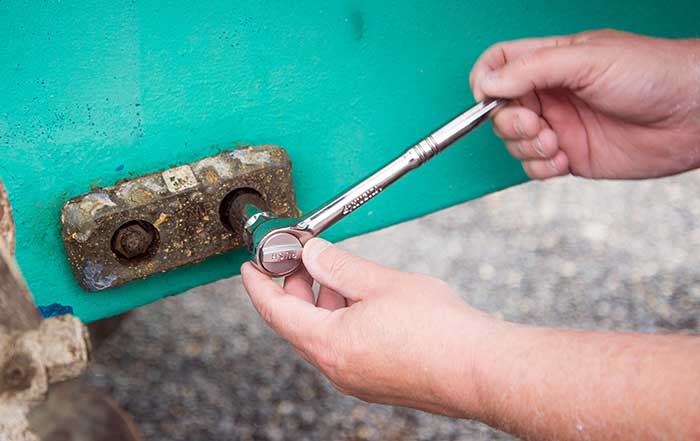
When the boat is out of the water, check and replace anodes if they are more than 50 percent wasted.
All tanks should be as empty as possible, and while it may not be practical to drain fuel tanks, it is relatively easy to drain water and waste tanks. Full tanks add significant weight to the boat, and empty tanks will put less strain on the boat's structure when it is sitting in an unnatural element on land.
Before the boat is hauled out of the water, tell the travel hoist operator about any underwater appendages, such as fin stabilizers or pod drives, transducers, speed wheels and other things not easily seen when the boat is in the water that could be damaged by the travel hoist slings. "We are familiar with most boat designs", says Leszynski, "but it is helpful if owners mention things that may be special about their particular boat".
Larger yachts often have what's known as a "graving plan," which is a layout of where blocking and other supports go when the ship is drydocked. Although you probably don't need to go to these lengths, a photo or two of the boat in the slings that you can share with the hoist operator is often appreciated, especially if the boat is rare or an unfamiliar type. A profile shot is the most useful. This is especially true with sailboats, as it will show the keel configuration, the position of any skegs and rudders, and where the shafts exit the boat.
Slings can scratch gelcoat, paint, and varnish. To avoid damage, ensure the yard has and uses soft muffs or plastic sleeves over the webbing on the straps. Once the slings have been correctly positioned, adding those little "sling here" marker labels, available from chandlers, is a great idea and will save time at subsequent haulouts.
On The Hard
If your boat is being lifted for anything more than an hour or so, often called a "short haul," it is likely that it will be placed on blocks in the yard and supported with jackstands. If this is the case, tell the yard about any relevant structural features of your boat. Some downeast powerboats, for example, have hollow keels aft, which could potentially suffer damage if the boat is improperly blocked and supported. In cases like this, blocks should probably run lengthwise rather than athwartships to provide adequate support.
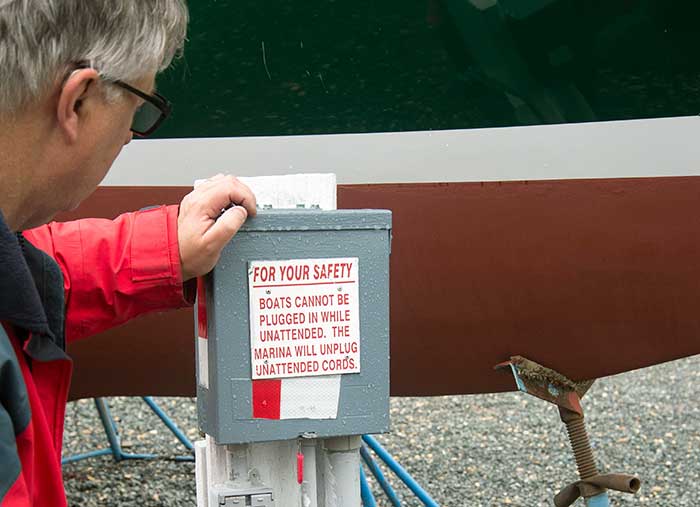
If you plan on doing any work on your boat, you'll most likely need access to power and water. Make sure that you have any necessary extension cords or adaptors as it is often up to you to provide these, not the yard.
As a general rule, the workers in the yard have much experience moving and blocking boats, so it's best to leave it up to them as to how they do it. By all means watch, but don't interfere unless you see something that is wrong or unsafe; if you see a problem, bring it up with the yard manager.
Once the boat is settled into her spot, inspect the jackstands. Ensure they have chains between them to prevent them from spreading, which could cause the boat to fall over. Be sure that the attachment points of the chain to the jackstands are secure. Sometimes the slits in the metal of the frame into which the chain links sit are torn or bent from use, which could result in slipping or failure. If a stand is severely rusted, ask to have it replaced.
Also check the ground beneath the jackstands. If the stands are resting on, for example, sandy or loose soil, and especially if there's a slope, this may present a problem in heavy rains. The majority of jackstands will have three or four legs and unless they are on a solid surface, they should have sturdy plywood pads or other good support placed underneath to distribute the weight over a larger surface area, preventing them from sinking into the ground. If you see any problems, discuss them with management as soon as possible
Sometimes when you are working on your boat, such as when applying antifouling, you may need a jackstand moved. An alternative to moving stands, which will often incur an additional fee, is to have some antifouling paint and brush in hand when the boat is lifted for relaunching and apply some paint to those areas covered by the pads prior to the boat being launched. If you can't be there to touch up the bare spots, often the yard workers will do it for you if you leave the paint and a brush. For your safety, and for that of your boat, do not attempt to adjust or move stands yourself; ask the yard to do it.
While You're At It
Irrespective of what other work you may have to do when the boat's out of the water, now's the time to check the anodes and replace them if they are more than 50 percent wasted. Also use this opportunity to inspect propellers, rudders, transducers, and seacocks. If anything seems amiss and it was not on your original to-do list, attend to it now.
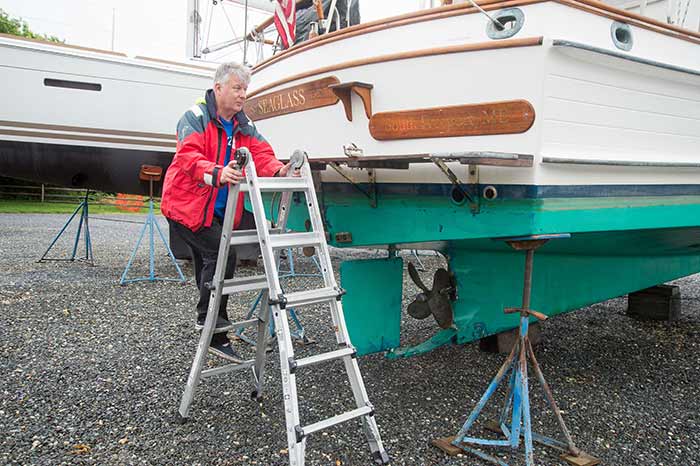
Don't rely on the yard having a ladder. Bring your own, and either take it with you or lock it up when you leave at night.
Launch Time
Once the boat is put back in the water, check the bilges carefully for leaks. Hoses that have been disconnected from thru-hulls have sunk more than one boat. If your boat has a drain plug that was removed when the boat was hauled, make sure that the yard staff know where this is or there may be a delay in getting your boat back into the water. Sometimes, because of shifting hull stresses while the boat isn't supported by the water, shaft alignment may be affected by a haulout, at least temporarily. Be sensitive to this possibility when you run the boat after coming from the hoist.
Pay your bill before launch time, or you may find that your boat can't go back in when you think. Most yards have a saying: "No cash, no splash."
8 Essential Questions To Ask Your Yard
What's the cost of hauling and relaunching? Some yards quote just the haulout price and some include the relaunch in their price. Usually haulouts are charged based on length of boat, but not always, so ask.
Can I work on my boat myself? Not all yards allow you to work on your own boat, often citing insurance concerns. Check on what's allowed if you plan on doing any work yourself.
Are there any "lay days" included? If your boat will only be out for a few days, there may not be any storage charges, but some marinas charge by the day, week, or month as soon as the boat is blocked in the yard.
Is there a fee to bring my boat to the haulout well, and how much is it? If you need the yard to move your boat because you're not able to, there'll most likely be an additional charge. If you're a long-time customer, though, you may be able to get it waived. Bimini or backstay removal may come with an extra fee.
Does the cost include a high-pressure washdown? Most marinas provide this service as part of a haulout, but ask, don't assume.
Where will you put my boat? After hauling, your boat will be blocked ashore. In a large marina, that could mean a long hike from the office or chandlery, and worse, possibly too far from electrical power or water, which you might need.
Can I bring in outside contractors? Marinas want you to use their services and may charge you a fee or even a percentage of your outside contractor bill. Most will require the contractor prove he's properly insured. Some prohibit outside contractors altogether, citing liability, though there is little risk to the marina if you and your contractor have the proper insurance.
When will my boat be relaunched? If you hope to use your boat the next weekend, you could be disappointed if the yard tells you it could be several extra days. Let your yard know in good time when you'd like to go back in the water, but be aware that sometimes tides and weather may preclude you from getting your ideal time and date.
— Charles Fort
Related Articles
The truth about ceramic coatings for boats.
Our editor investigates the marketing claims of consumer-grade ceramic coatings.
Fine-Tune Your Side Scan Fishfinder
Take your side-scanning fishfinder off auto mode, and you’ll be spotting your prey from afar in no time
DIY Boat Foam Decking
Closed-cell foam flooring helps make boating more comfortable. Here’s how to install it on your vessel
Click to explore related articles
Contributing Editor, BoatUS Magazine
A marine surveyor and holder of RYA Yachtmaster Ocean certification, BoatUS Magazine contributing editor Mark Corke is one of our DIY gurus, creating easy-to-follow how-to articles and videos. Mark has built five boats himself (both power and sail), has been an experienced editor at several top boating magazines (including former associate editor of BoatUS Magazine), worked for the BBC, written four DIY books, skippered two round-the-world yachts, and holds the Guinness World Record for the fastest there-and-back crossing of the English Channel — in a kayak! He and his wife have a Grand Banks 32.
BoatUS Magazine Is A Benefit Of BoatUS Membership
Membership Benefits Include:
Subscription to the print version of BoatUS Magazine
4% back on purchases from West Marine stores or online at WestMarine.com
Discounts on fuel, transient slips, repairs and more at over 1,200 businesses
Deals on cruises, charters, car rentals, hotel stays and more…
All for only $25/year!
We use cookies to enhance your visit to our website and to improve your experience. By continuing to use our website, you’re agreeing to our cookie policy.

Tales (not just) from the high seas

Sailboat Haul Out Methods: A Cruiser’s Guide
There are many sailboat haul out methods, but which (and where) would we choose as our favourite in south-east Asia?
We’ve been hauling out our boat, Esper , since 2004 (in south-east Asia since 2014) so we have plenty of experience. But with all that practice, and no matter how competent the yard, it’s always somewhat nerve-racking. A sailboat is supposed to be in the water, isn’t it? And once you put it on land, all kinds of stresses and loads appear that weren’t there when she was floating.
Hauling out is particularly disconcerting when it’s the first time with a new yard and a new method.

That being said, there are some general guidelines and best practices that can help you choose the most appropriate method for hauling out your sailboat. Here are some options to consider:
If your sailboat is small and light enough, you may be able to use a boat trailer to haul it out of the water. It is a cost-effective option, as you can often rent a trailer and do the haul out yourself. But, it may not be suitable for most cruising boats.
Travel Lift
A travel lift is a type of crane that can lift your sailboat out of the water and onto land. It’s a common method for hauling out larger sailboats, and is typically done at a boatyard or marina. It feels safe and sturdy when you’re on your boat as it moves to its new temporary home in the boat yard
As sailor and boat owners, we can tell you that there is no one-size-fits-all answer to the question of the best method to haul out a sailboat. The ideal method will depend on a variety of factors, such as the size and weight of the boat, the type of hull, and the location of the haul out facility.
Hydraulic Trailer
A hydraulic trailer is a specialized type of boat trailer that uses hydraulic lifts to raise and lower your sailboat. It is a good option for boats that are too heavy for a regular trailer, but not large enough for a travel lift. The initial outlay is less than a travel lift and many yards in south-east Asia have this option

A railway system uses a cradle on rails to lift your sailboat out of the water onto land. We have seen two of these in south-east Asia (both Thailand) and they seem sturdy.
Ultimately, the best method to haul out your sailboat will depend on a variety of factors, including the size and weight of the boat, the location of the haul out facility, your own experience and confidence in the yard. Before making a decision, it’s important to do the research and consult with a professional or other cruisers in the area who may have used the facilities.
Southeast Asia has all of these methods, and here at Medana Bay, they employ the simple tractor and trailer method.
Hauling out on a track at PSS
But before this, when we arrived in south-east Asia, we hauled out at PSS in southern Thailand. There we undertook a total refit and filmed the year-long process. If boat work in exotic locations is your passion check out our TOTAL REFIT playlist .
PSS is a proper old-fashioned fishing boat yard, so it’s not the prettiest of places. They employ a winch and railway system for haul-out. In a nutshell this means that cradle is rolled into the water on a trolley, the boat manoeuvred on to it, then pulled up until the keel is securely resting there.
Once the boat is in place, a winch system pulls the whole caboodle out of the water onto the yard tracks where it is manoeuvred into its parking slot.

Pangkor Marina’s hydraulic lift
Our next haul-out was at Pangkor Marina in Malaysia, where they use a hydraulic lift with inflatable pads.
This is probably our favourite method of haul-out.
You simply park the boat on top of the trolley, the operator inflates the bed, and then the boat is comfortably pulled onto land! Couldn’t have been easier!
The worldwide Travel Lift
Of course, south-east Asia also has classic travel lifts of varying sizes too.
Krabi Boat Lagoon Marina has the most beautiful hard-stand we’ve every encountered. Here, the lift is planted over the slip and you drive your boat into position. There are loads of staff to take lines, hold the boat, and attach slings, allowing you to get off and go for breakfast while the staff haul and park your boat.

But not all yards are created equal, and although Kudat does have a travel lift, we discovered that access to the slip was tricky.
There were unusual currents, countless obstacles and a jagged entrance. And once we made it through the obstacles we were left to rely on help from a sailor mate with a fag in his mouth who caught our line and held us in place (because there was no cleat)!
Jamie reveals our ALL-TIME FAVOURITE ANTI-FOUL PAINT in episode 339 on our YouTube channel . Watch it here on followtheboat or go straight to YouTube.
How often should I haul out my sailboat? It’s recommended to haul out your sailboat at least once a year for routine maintenance and inspections. If you notice any issues or damage, it’s important to haul out your sailboat as soon as possible.
Can I leave my sailboat on the hard for an extended period? Yes, you can leave your sailboat on the hard for an extended period, but it’s important to take the necessary precautions to prevent damage. This includes regularly checking the hull and ensuring that the sailboat is properly secured.
How much does it cost to haul out a sailboat? The cost of hauling out a sailboat can vary, always check with the yard first.
If you like our content and would like to support us, we will give you ad-free access to our videos before they go live to the public, discounts in our shop, access to Jamie’s iconic full-res photographs, and supporter-only blog posts. Click our ugly mugs for more info!

Leave a Comment Cancel Reply
You must be logged in to post a comment.

Everything to Remember when Hauling Out a Boat
Annual Maintenance Routine and Antifouling Bottom Job
Shortsighted boat owners who lengthen the time between haul outs cost money in the long run. Conventional wisdom says it pays to haulout annually for hull painting and maintenance, but some folks stretch that period to 18 months or even two years. The pros know better and keep their bottoms as clean as their topsides.
Once a Year
“I recommend hauling out every year to catch the bottom before the growth starts to build,” said Joe Zammataro, service manager at V&G Yachtworks in Dania Beach. “Because once the growth starts to build, that’s when you get water penetration and lose performance and fuel efficiency.”
Overall, the haulout service for a 50-foot vessel focuses on three main categories: running gear, through-hull fittings and bottom paint. Each category is important, and within each are sub-categories that may or may not pertain to a vessel, depending on the hull material, age and known performance and mechanical problems.
Running Gear
“Some boaters pay very little attention to their running gear,” said Michael Carey of Florida Marine in Riviera Beach. “If it’s not aligned and working properly they are just throwing money away in regard to efficiency and wear and tear.”
Most captains have picked up clues during the boat’s operation that there could be a running gear malfunction, indicated by prop vibration or poor engine performance. Once the boat is hauled out and blocked, the service team works on the running gear problems first, because parts may need to be ordered.
“The props can be sent outside the yard for dynamic balancing, and back in time for re-launching,” said Michael Bach, service and sales manager for Rybovich Spencer in West Palm Beach. “The performance records on board and other fixed datum give the propeller shops the required information to tune the props. The boat’s records also help determine whether more work needs to be done, such as drawing the shafts out of the boat. You will only do that when needed.”
Running gear and outdrives will be cleaned of fouling, and can be painted with special paint systems. Zinc anodes are usually replaced even though some of the old anode is still there. Strut bearings will be inspected to check for excess clearance, and strut bolts are checked for tightness, corrosion or leakage. Engine mounts are checked if vibration has occurred.
“A good tip is to do a thorough sea trial prior to hauling the vessel,” said Paul Engle, president and general manager of Bradford Marine in Fort Lauderdale. “That way problems can be pinpointed a lot faster.”
Through-Hull Fittings
A physical inspection of all the through-hull fittings is done. Metal through-hulls last longer and are more damage resistant, but they will also corrode, and the evidence of corrosion is a green or white residue. Plastic through-hulls are non-corrosive but will degrade after long-term exposure to ultra-violet light.
Inlets for the engines and generators, and drains for the bilge and other outlets, are fitted with seacocks. Seacocks allow the through-hull to be closed off, and the position of a lever-type handle tells you instantly if it is open or closed.
The service team will inspect the through-hulls and seacocks, remove marine growth and inspect for corrosion and degradation. Prevention is key to ensuring seacocks work properly, and its recommended that the seacock handle should be moved through its fully closed and fully opened path once a month.
Bottom Painting
The last step in the process is prepping the hull and applying the bottom paint. The purpose of bottom painting is to prevent the growth of barnacles and other evidences of fouling on the bottom of the boat. Almost all recreational boaters use an ablative paint that wears off over time. Conventional, or hard paint is used in high-performance applications, where keeping drag to a minimum is crucial.
For well-maintained boats, the bottom-painting procedure is similar for fiberglass-, aluminum- and steel-hulled boats. The bottom is mechanically sanded and profile work is done, and then the ablative paint is applied. However, a fiberglass boat that hasn’t been hauled in a few years would probably have blister problems. Steel boats that have been in the water a long time would likely be suffering from corrosion, as would aluminum boats. Boats with these problems need more preparation work, and costs increase with the additional time and labor.
Some boaters scrub their own hull bottom monthly or quarterly, or hire someone to do it. This can extend the time between haulouts for bottom paintwork, but obviously does not address running gear or through-hull maintenance. Also be aware that when you clean the bottom, you also clean off the paint that protects the bottom.
The proper sanding and removal of old paint and the prep of the bottom is crucial to getting a long-lasting paint job. Ablative paint polymers wash away slowly over time with water movement, and the fouling organisms are scrubbed away with it.
Paint is normally applied by a roller, although some yards apply paint with a sprayer. A sprayer is often used on larger boats. One coat of paint is normally sufficient for boats that will be hauled annually. “Unless the customer is going to be gone on a long trip for two or three years, we feel that one coat will last a year,” Engle said. “Otherwise it gets expensive for the customer.
Service Timeline
On a 50-foot fiberglass sportfishing boat with a good maintenance record, a haulout, service and re-launch can be completed in four to five days. The caveat to that time frame concerns what the service team finds once the boat is out of the water. In general, though, here’s how a haulout usually proceeds:
1) Haul boat out, pressure wash immediately before the hull dries
2) Block the boat and stage for out-of-water work
3) Inspect and confirm the work list and original estimate
4) Negotiate and finalize add-on work found during out-of-water inspection
5) Begin work on clearances, running gear, propellers
6) Inspect and repair through-hull fittings
7) Remove and replace zinc anodes
8) Prep the hull and apply bottom paint
9) After paint is properly cured, re-launch boat
Research the fees associated with hauling out. Call around your local area to shop rates and pick an operation that has a proven track record. Other fees that may be added on include insurance on the job and an EPA charge to dispose of hazardous waste. EPA charges run about 2.5 percent of the bottom job quote.
Read More...
{ item.title } { item.quantity } items { item.price | money } each { item.line_price | money } total for item
{ cart.total_price | money_with_currency }
Boat Reviews
- Boats Specs
- Marine Pros
- Boat Insurance
- Boat Warranties
- Boat Transport
- Boat Towing
- Marine Forecasts

Your Ultimate Boating Resource

Expert Tips for Boating in Shallow Waters with Confidence

Boating in shallow waters can prove to be a headache for many recreational boaters. Whether you’re out on a fishing trip or simply enjoying the beautiful scenery, navigating shallow waters requires both skill and patience to avoid damaging your vessel or encountering accidents. Here are expert tips to help you confidently navigate shallow waters and keep your boating adventures worry-free.
Understanding Your Boat’s Draft
The first step to confidently boating in shallow waters is understanding your boat’s draft. The draft is the depth of water needed for your vessel to float freely without touching the bottom or propellers getting damaged. Make sure to check your boat’s owner manual for its draft specifications, and always give your vessel a margin of safety. This extra buffer will ensure you have enough room to maneuver should you need to alter your course quickly.
Selecting the Right Equipment
It’s essential to invest in boating equipment designed with shallow water in mind. Some options to consider are:
- Shallow water anchors : These anchors provide additional stability when fishing or idling in shallow waters. They can be easily deployed and retracted, typically using a wireless remote control.
- Depth finders : A reliable depth finder will help you monitor the water depth, ensuring you stay within safe limits. Some depth finders also display contours, making it easier to avoid shallow spots and underwater hazards.
- Shallow water drive systems : These systems enable your engine to operate in shallow waters by allowing the engine and propeller to be lifted away from the boat’s bottom. This reduces the risk of your propeller hitting the bottom, damaging your boat, or worse, getting stuck.
Planning Your Route
Before you start your boating adventure, make sure to carefully study the area and plan your route. Obtain updated nautical charts and topographical maps, which indicate the water depth, bottom contours, and potential hazards such as sandbars, rocks, or obstacles. Keep an eye on the tide levels, as this can significantly affect the water depth. Pay close attention to changes in water color, which can indicate a change in depth, and be cautious when approaching unfamiliar areas.
Reducing Your Boat’s Load
When boating in shallow waters, it’s essential to know that reducing your vessel’s load can significantly impact its draft. This means that by carrying less weight on board, your boat will require less water depth to float freely. Consider limiting the passengers, gear, and fuel when navigating through shallow water channels. However, also ensure you have the essential safety gear and enough fuel for your trip.
Safe Speed and Trim
Maintaining a safe speed is crucial for boating in shallow waters. Faster speeds can lead to higher chances of accidents or damage to your vessel. When unsure about water depth or obstacles, always reduce your speed and proceed cautiously.
Additionally, adjusting the trim of your boat can also help you navigate shallows more confidently. Trim refers to the boat’s angle in the water. If the front (bow) is raised, the boat’s draft will decrease, ensuring lesser chances of hitting rocks or underwater debris. Practice adjusting your boat’s trim to find the perfect angle for shallow water navigation.
Handling Shallow Water Hazards
Despite your best planning, you may still encounter hazards while boating in shallow waters. If you happen to run aground, remain calm, check for leaks or damages, and cautiously reverse out of the situation. It’s essential to familiarize yourself with your boat’s handling capabilities and limits, which will help you tackle any shallow water scenario.
Boating in shallow waters can be a rewarding experience, provided you understand your boat’s capabilities and take necessary precautions. By knowing your boat’s draft, selecting appropriate equipment, planning your route, reducing your boat’s load, and learning about safe speeds and trim, you can confidently navigate shallow waters and fully enjoy your time on the water. Always practice caution, and remember that patience is key when handling shallow water navigation. With these expert tips in mind, your shallow water boating adventures are sure to be memorable and safe.
RELATED ARTICLES
Overview of the 2024 sea-doo rxp-x 325, overview of the 2024 parker offshore 2900 cc, what your boat’s beam is and why it matters, power cats of 2024: ultimate guide to the top power catamarans this year, navigating the heat: 10 safety tips for a safe boat ride in the summer heat, latest posts, don't miss, our newsletter.
Get the latest boating tips, fishing resources and featured products in your email from BoatingWorld.com!
What type of wood is used for pier pilings?
What is the difference between a dock and a floating pier, what is the proper technique for pulling a beginner wakeboarder, what does ‘no wake’ mean on a lake, what is the difference between wash and wake, highs, lows, and tidal know-how: a deep dive into ocean currents, 10 essential tips for fishing near private property, the benefits of using a drift sock: guidance for anglers, lure fishing: secrets for imitating live bait and attracting fish, explore the untapped depths of america’s best bass fishing spots, outboard motor maintenance: tips for keeping your engine in top shape, the essential boat tool kit: tools every boater needs, diy boat building: 8 tips and tricks for building your own vessel, the art of miniature maritime craftsmanship: ship in a bottle, antifouling paints: a guide to keeping your boat shipshape, beginner’s guide to standup paddle boarding: tips and techniques, boating for fitness: how to stay active on the water, kayak safety: how to stay safe on the water, anchoring in a kayak or canoe: how to secure your small boat, overview of the 2024 yamaha 252sd, overview of the 2024 tiara yachts 48 le, overview of the 2024 bass cat jaguar sts, 2024 pursuit os 445: an overview, 2024 aquila 47 molokai review, 2024 sea-doo switch 13 sport review, gear reviews, megabass oneten max lbo jerkbait review, fortress anchors fx-7 anchoring system review, fortress anchors fx-11 anchoring system review, fortress anchors commando anchor kit review, fortress anchors aluminum anchors review, stay in touch.
To be updated with all the latest news, offers and special announcements.
- Privacy Policy

Smooth Sailing Marine
The ultimate collection of boat essentials for enthusiasts, by enthusiasts
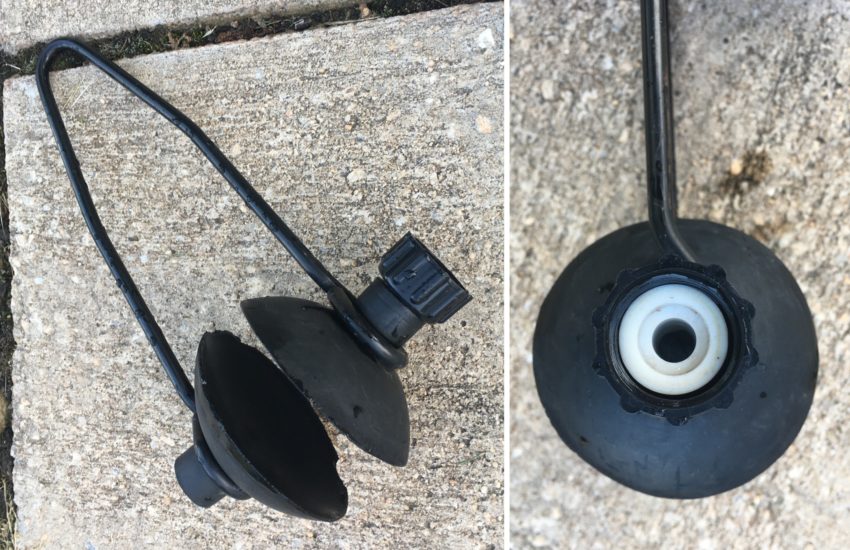
How To: Run Your Boat Out of the Water On Muffs, or Motor Flushers
It’s important to understand how your boats engine works to keep it safe during operation. One of the biggest things to know is it uses water to stay cool, similar to a vehicles cooling system. The major difference between a boat and a vehicle is most boats pump the water it is submerged in from its outboard and through the engine. Some boats do have isolated cooling systems, but the sea water is still pumped into part of the system and through a heat exchanger instead of running through the engine.
Regardless of the style cooling system your boat has, it’s important to know that the outboard either needs to be submerged in the water while running, or needs to be fitted with a supply of water if on land or out of the water. If your boat is currently out of the water, the typical and most universal way of supplying water to it is by using a water flusher, otherwise known as “muffs” or “ear muffs”. These muffs can be seen below.
Types of Engine Flushers
There are a few different styles of muffs you can fit on your boats outboard. The differences are fairly subtle, but we wanted to list them to make readers aware of the different options. Read on below to see the different options offered.
Basic Style
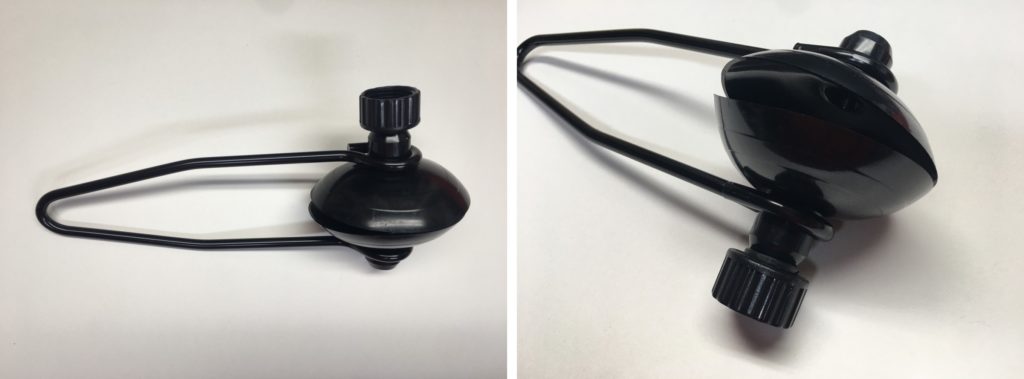
The basic style set of outboard muffs simply has a hose connection on one of the cups, and a cup on the back side that has no water flow and only holds the water in the water intake. On the intake holes for the water on an outboard, either side can be used to feed water as they are connected and feed water to the same passage to the intake water pump. Therefore, only one cup needs a water supply while the other keeps any extra water from exiting the water intake passage.
Dual Flow Style
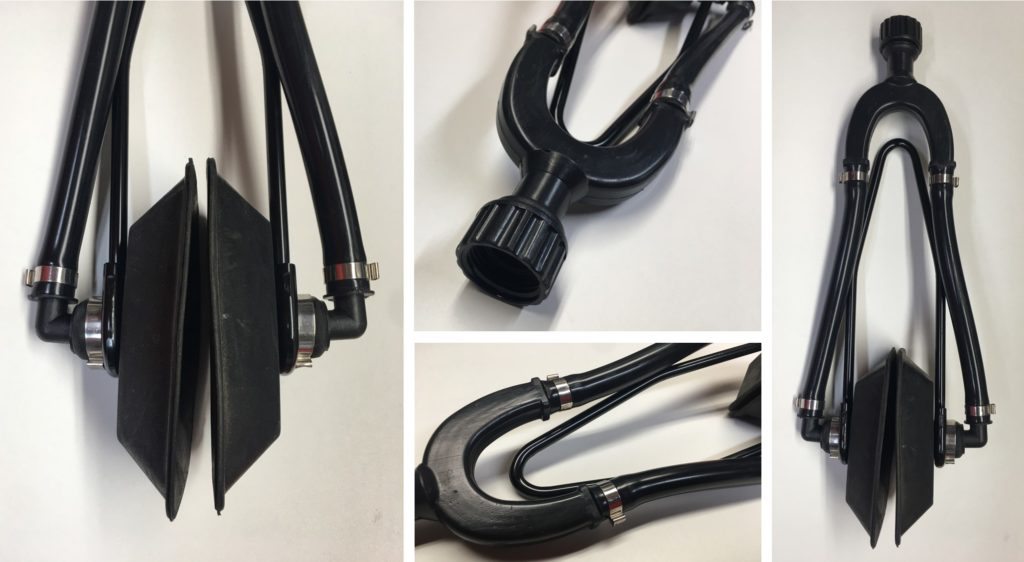
Another style of muffs that are available is a dual flow option that supplies water to both sets of intake holes on the outboard. While the basic style will get the job done, this style is closer to how the system will run in actual operation with water being fed to both sets of intake holes on the outboard. The water is simply supplied to a T-fitting and split to feed both cups on the flusher.
Large Style
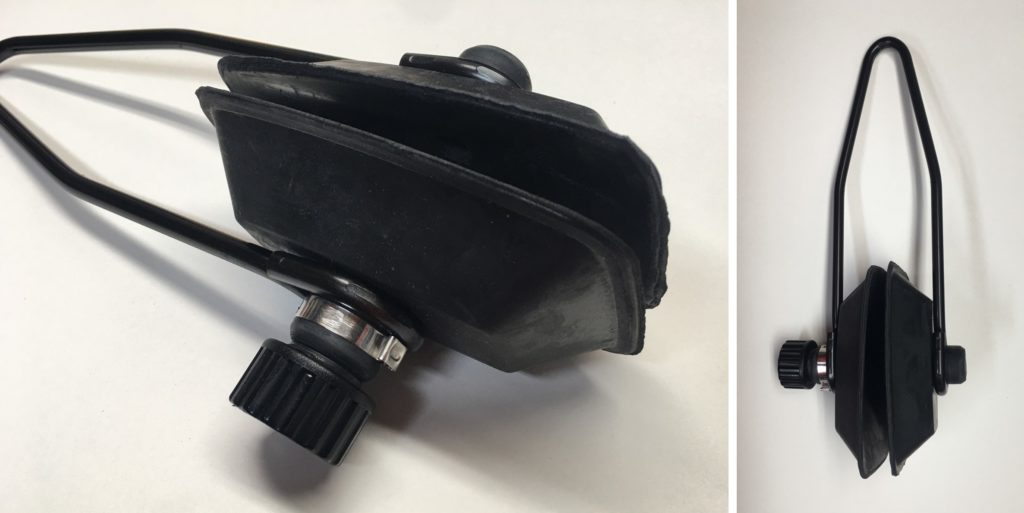
The final style of muffs on the market are a set that have larger cups for outboards that have sets of intake ports that are spread further apart. These are fed from a single side similar to how the basic set is fed but will still deliver enough water to ensure your outboard stays at proper operating temperatures.
How to Run Your Boat Out of Water
Below we’ve given a brief procedure on how to properly install a set of muffs on a boats outboard. It’s important to take care when installing and running motor flushers on your boat as the engine can be damaged if it does not get the proper amount of water it needs for cooling. Taking the time to identify the intake ports and confirming water is flowing through your engine will save you a headache as well as money by avoiding costly repairs.
1. Identify the Water Intake Ports
All outboard units have a water intake passage to receive the water that is pumped to the engine for cooling. In the picture below, the water intake passage on this particular unit is outlined with the orange square. There are a series of holes that accept water into the unit. These water intake holes are what the muffs will be covering.
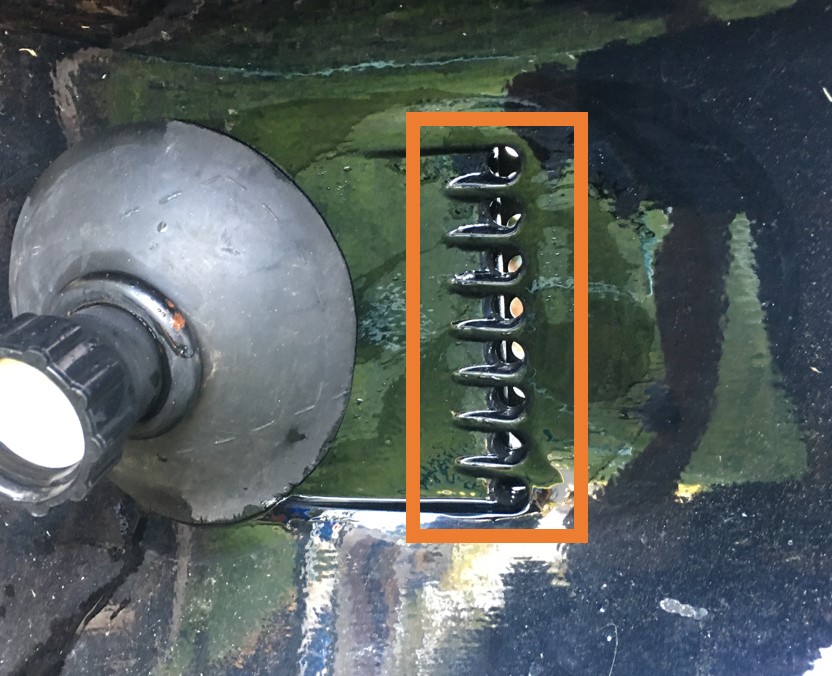
2. Fully Install the Muffs in the Proper Location
It’s important to note there are holes located on each side of the outboard housing. When installing the muffs they will need to cover the intake holes on each side. Once positioned over the holes on each side, a water hose needs to be fastened to the side that has the threaded insert as seen below. Note the muffs cover all of the water intake holes on both sides of the lower unit. The pictures below show a motor flusher properly in position and connected to a water hose.
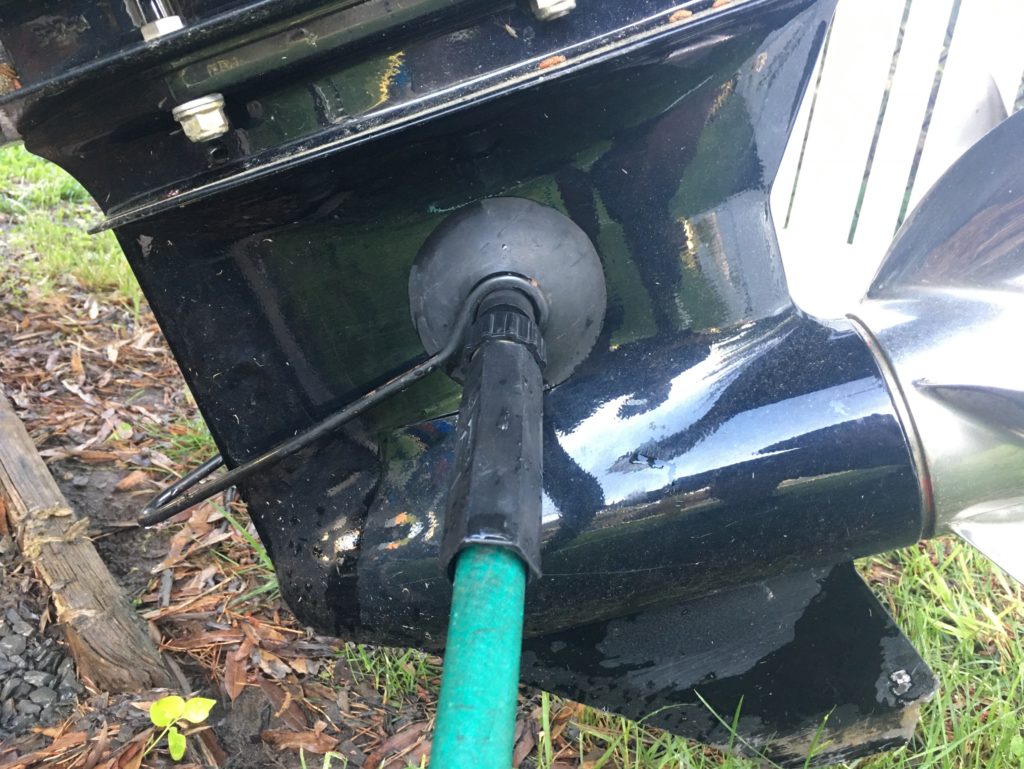
3. Turn on the Water Supply
Once the hose is installed and the muffs are firmly in the proper position, turn the water on to bring water through the hose to the outboard. Once water is going to the intake ports the boat can then be started. Make sure to verify the water is going to the muffs before starting the engine, this can be verified as water will be leaking out around the muffs.
4. Start the Boats Engine
At this point, once the water is turned on and running to the outboard unit, the boat can be started. Remember to only start the engine once the water is verified at the outboard itself. If there is an unexpected kink or hole in the hose, water may not reach the unit and could cause damage if overheated.
5. Confirm Water is Circulating Through the Engine
Once the engine is running you should always confirm water is exiting out of the proper ports after it circulates through the engine. This is to confirm the engine is in fact getting water through the entire cooling loop and nothing is clogging it or keeping it from transferring from the muffs to the engine.
Here’s a good video we found that describes the process straight from Shoreline Marine themselves!
Final Thoughts
Congratulations on learning how to properly hook your boat up to muffs! This is a great tool to have to perform work on your boat while it is out of the water. There are many times you’ll want to start your boats engine out of water whether it’s to warm the oil before an oil change, or winterize it before the freezing weather comes your way. Hopefully this article has given a good description of the importance of running your boat with muffs and how it’s properly done!
Smooth Sailing Marine is powered by product recommendation partnerships.
If we have helped you in your product decision or marine project, you can help us by purchasing through our links. We thank you for your support, we couldn’t be here without our awesome readers!
Leave a Reply Cancel reply
Your email address will not be published. Required fields are marked *
Save my name, email, and website in this browser for the next time I comment.
Thanks for reading!

How To Pump Out Your Holding Tank

Last Updated by
Capt Chris German
June 15, 2022
Everyone Poops. One of the grossest mysteries of owning a boat is what happens when it goes down. Where does it go? How long does it stay? And how do I get rid of it?
The subject of holding tanks and poop is one that is almost too difficult to broach in polite company. No one wants to admit they even do it, let alone what they do with it afterwards. So today, we pull back the curtain and look deep into the subject that is pooping on a boat.
Table of contents
The black water tank
I am not sure that it Is it any coincidence that the most well known private mercenary force responsible for countless war crimes shares the same name as the tank that holds the foulest of human byproducts.
Black Water.
The very term brings up secrets, unmentionables and private human functions. So I guess it makes sense that they share a name.
The black water tank on a boat usually has a nasty smell and as such is usually located under the least desirable bunk on the boat- usually under the vee berth. It gets this smell not from your colon necessarily, but from the sodden, festering marinated combination of all forms of human effluence. This mixed with paper products, water and stirred exuberantly by the motion of the boat and left in an oxygen free environment for partial anaerobic consumption is to blame.
It is these anaerobic bacteria, combined with the bacteria of your lower bowel that create a truly odoriferous experience for anyone forced to sleep in the vee berth or tasked with the duty of emptying said tank.
The grey water tank
This is the tank that holds the washing water on a boat. The grey water tank is a much less innocuous sounding facility and not all boats have them. Some boats combine grey and black water into one tank, while others separate them. If your boat navigates exclusively in non-discharge zones along Coastal and Inland waters, you are required to collect all of the “grey”water.
Grey Water by definition may contain no fecal matter. It may, however, contain bacterias and soap products that are noxious to the water environment and should not be discharged in bodies of water that do not intersperse readily with the world ocean environment.
The presence of these bacteria, (particularly if you are one who urinates in the shower) can make this water very smelly and almost equally gross as black water. Other things like food particles, dirty clothes and bath water also give this water a distinctly disgusting quality. As such, it should never be dispersed on any human or animals consumed plants or food sources.
The fresh water tank
This tank should never be confused with either of the previously mentioned tanks as this is water that can be consumed by humans and animals. It really bears no relation to pumping out the holding tanks other than while you are at the pump out dock, oftentimes there is a fresh water hose available for potable water that should never be used in any way with your holding tanks.
You may also find the fresh water fill on the deck of your boat in a similar configuration to your waste water and holding tanks. Please never confuse these two filling ports on your boat and if you do decide to fill your freshwater tank while on the pump out dock, be sure to use the spigot that says potable or drinking water and never cross-contaminate the hose.
How to use the pump out dock
In many places around the world, a dock that is designed exclusively for pumping boats out is available to recreational boaters. You will know it is a pump out dock because it should have lots of signs on it. It will have a prominent fixture on it that has a two inch flexible hose coming off the side. It is likely to have a yellow or black handled ball valve at its end with a sight glass on it.
Not every pump out dock is the same and sometimes you are charged a fee to use the pump out, but the best communities I have found have free pump out services for the public. In the places I have lived where I used the pump out, namely Connecticut, North Carolina and Utah, the systems are pretty universal.
When you pull up to the pump out, you will likely encounter other boaters. Be considerate. If you have a 24 foot boat, please don’t use slips where a 65 foot boat can only park. Also, please don't park right in the middle of a dock if it can fit more than one vessel.
Pull your boat to the end, but not so far that the hose will not reach your boat. Use your best judgement, but please be considerate to others.
Once you're docked, now is time to pump. Take the hose off the pumpout housing and drag it to your boat. You should have a pump out fitting that screws into your waste hole on your boat. They come in 2 inch and inch and half threaded sizes so make sure you have the right size for your boat. Unscrew the deck cap and put the cap in a safe place so you don't drop it overboard.
Now, screw the pump out fitting into your waste hole tight enough so that air cannot escape but not so tight that you can’t ever get it out. Next, take the ball valve with sight glass and fit it onto the lip of your pump out fitting. There should be two levers on either side of the valve that flip upward to secure the hose fitting to your pump out fitting. Once you have flipped those levers, you can turn the pump out on by pressing the green button on the pump out housing.
You will now hear a pump kick on and you can open the handle on the ball valve. You should see a brown or grey slurry get sucked up into the hose. Sometimes you may need to open and close the handle partially to establish the suction on weaker pumps.
The hose will then transport the fluids up to the housing and then pump it down the docks to a septic tank or sewer system on shore.
You will know you're finished when the pump out can no longer pull a steady stream of fluid from your tank by looking in the sight glass. Close the valve and unlatch the levers and pull the hose off of your pump out fitting. Place it in the water while you take the cap off your grey water tank and repeat the process.
When you have pumped both tanks dry, open the vale and place it back in the water. This will suck up sea water and flush any solids that got stuck in the line up into the system. Close the valve and neatly coil the hose back onto the hook on the pump out housing.
I like to use the hose that is designated for pump out to wash down the area and put a little fresh water into the tanks. You can repeat the pump out process if you want to get that rinse water out, but I find it dislodges solids over time so I like to leave a few inches of water in my tanks after I have pumped them out.
Now you can flush a sanitizing pouch, also known as a “blueberry”, into the tanks and be on your merry way.
The pump out boat
There is another service offered by some marinas and municipalities - a mobile pump out. A pump out system is installed on a boat that can come directly to your boat on the dock or mooring. Sometimes this is a free service and other times it is pay service, but either way you should tip the pump out guy who drives the boat because it's a nasty job.
Many times the pump out guy will do all the work, but you really can help him by telling him if your boat is vented or not. Vented boats have a tube that vents out the side or through the cabin top that allows vapors to escape and prevents a vacuum from forming when you pump the tanks.
If your boat is not vented, you run the risk of imploding the tanks when you pump out, so you will need to open the traps in the toilet to allow air to come in while pumping out. This goes for the pump out dock as well, but in my experience is much more important with the pump out boat because they generally have stronger pumps since they don't have to suck the fluids uphill to a facility.
Keeping you and your tank healthy
There are a few million infectious diseases in a holding tank that can get all over the place when you are pumping out. Taking precautions like not touching your face, washing your hands, using hand sanitizer and using gloves should keep you safe. Some folks like to wear a face shield and apron when they use the pump out cause there is a chance that things can spray and get really nasty.
You can also minimize the colonization of bacteria in your holding tank by pumping it regularly and using additives that help break down the solids and decompose them into a more fluid consistency. One of our favorites is Happy Camper , an additive you mix with water and pour into your holding tank. It kills odors, breaks down solids and makes living with holding tanks that much more appealing.
Another thing you could do occasionally is wash out your holding tank with a multi-directional hose fitting. They are available online. We use a long rod to stir our tanks every once in a while in addition to the hose to break clumps of paper products and chunkids.
There is also a theory that if you dump a couple bags of ice into your tank that the ice chucks will scour the solids from your tanks and help clean it out. I think this could work on a boat that is moored much better than one at the dock, but try and let me know how it works for you.
Finally, bleach will sanitize your tank but it also kills all the good microbes that help break down the materials in your tank. Once a season, I have been known to give my plastic tanks a good cleaning with bleach but I would never use bleach on a bladder or non-rigid tank for fear that it degrades the fabric.
Clogs will happen
It's a nightmare when it does happen, but clogs do occur. Usually it is because someone flushed something they shouldn’t have flushed and it gums up the tank or lines.
A key to preventing clogs, especially if you have young ladies on your vessel, is to make it clear to them that nothing goes in the toilet that hasn’t gone through your mouth first. Keeping a trash can nearby in the head helps enforce this rule. Some folks even resort to private shaming with a sign in their head that reminds their guests of this rule.
Whatever you do, keeping that stuff out of the tank is your first option. If it does get in there or you have a clog from some other way, there is not much to do to fix it but get manual. Don your face shield and gloves and go in to find where the clog is located and break it up.
Toilet paper is a big culprit when it comes to clogs so using fast decomposing paper is a good choice. Other ways it can happen is when your guests don’t use enough water to wash the solids down. If this is the case, you might be able to use a high pressure nozzle with your hose to blow the clog apart. Keep an eye on your sight glass to make sure you have washed the entire clog out of your tank and make sure you don't use that hose for any potable water purposes.
Pumping a boat out is a dirty business but we all have to do it. Taking care to keep your tank healthy and free of clogs will cut down on smells and make your vee berth that much better to sleep in. Don't be a jerk at the dock and if all else fails, ask your fellow boaters for a hand in learning how to pump your boat out. Most people are pretty nice when it comes to pumping out because no one likes to do it. Thanks for reading. Do good, have fun, and sail far.
Related Articles
Capt Chris German is a life long sailor and licensed captain who has taught thousands to sail over the last 20 years. In 2007, he founded a US Sailing-based community sailing school in Bridgeport, CT for inner city youth and families. When Hurricane Sandy forced him to abandon those efforts, he moved to North Carolina where he set out to share this love for broadcasting and sailing with a growing web-based television audience through The Charted Life Television Network.
by this author

Most Recent

What Does "Sailing By The Lee" Mean?
Daniel Wade
October 3, 2023

The Best Sailing Schools And Programs: Reviews & Ratings
September 26, 2023
Important Legal Info
Lifeofsailing.com is a participant in the Amazon Services LLC Associates Program, an affiliate advertising program designed to provide a means for sites to earn advertising fees by advertising and linking to Amazon. This site also participates in other affiliate programs and is compensated for referring traffic and business to these companies.
Similar Posts

How To Choose The Right Sailing Instructor
August 16, 2023

Cost To Sail Around The World
May 16, 2023

Small Sailboat Sizes: A Complete Guide
October 30, 2022
Popular Posts

Best Liveaboard Catamaran Sailboats
December 28, 2023

Can a Novice Sail Around the World?
Elizabeth O'Malley

4 Best Electric Outboard Motors

How Long Did It Take The Vikings To Sail To England?

10 Best Sailboat Brands (And Why)
December 20, 2023

7 Best Places To Liveaboard A Sailboat
Get the best sailing content.
Top Rated Posts
Lifeofsailing.com is a participant in the Amazon Services LLC Associates Program, an affiliate advertising program designed to provide a means for sites to earn advertising fees by advertising and linking to Amazon. This site also participates in other affiliate programs and is compensated for referring traffic and business to these companies. (866) 342-SAIL
© 2024 Life of Sailing Email: [email protected] Address: 11816 Inwood Rd #3024 Dallas, TX 75244 Disclaimer Privacy Policy
How did the superyacht Bayesian sink? Experts say weather was just one factor
Divers searching for 6 missing people locate 5 bodies inside wrecked yacht's hull.

Social Sharing
A complicated search effort is underway deep beneath the surface of the Mediterranean Sea, off the coast of Italy, where a superyacht sank early Monday during a fierce storm.
Dive crews are attempting to enter the wreck of the Bayesian, a 56-metre long British-flagged luxury vessel, which is sitting in some 50 metres of water near the Sicilian fishing village of Porticello.
Fifteen of the 22 passengers and crew members on board were rescued. Divers searching for six people considered missing, including British businessman Mike Lynch, located five bodies inside the yacht's hull on Wednesday, and retrieved four of them from the water.
Searchers previously recovered the body of Recaldo Thomas, the ship's Canadian-Antiguan cook, in the water not far from where the Bayesian sank.
- Diving team finds 5 bodies in Sicily yacht search
- Canadian dead, several others missing after superyacht capsizes off Sicilian coast
Questions have emerged about why a boat designed to handle severe weather sank so rapidly and whether or not some of its features could've been a factor in its demise. Maritime experts say investigations may, in time, reveal what led to the disaster.
"There needs to be an investigation as to why this happened, what went wrong and, you know, how to prevent it in the future cases," said Simon Boxall, an oceanographer and senior lecturer at the University of Southampton in England.

Canadian dead, others missing after superyacht sinks near Sicily
How did the bayesian sink so quickly.
Grainy footage from closed-circuit cameras on the shore broadcast on the website of the Giornale di Sicilia newspaper showed the Bayesian's majestic mast just before it disappeared.
Karsten Borner, captain of the Sir Robert Baden Powell, which rescued the survivors who managed to get into a lifeboat, told The Associated Press he was close enough to be able to see the Bayesian as the storm came in.
"A moment later, she was gone," he said.
The survivors told the rescuers they went flat on the water "and were sunk in two minutes."
Boxall said vessels rely on being able to steer and navigate stormy seas, but the Bayesian was anchored and stationary, which likely made it more vulnerable to the storm and, potentially, a waterspout , or mini tornado that creates a whirlwind over the surface of the sea.
He said it was also dark, meaning "you wouldn't see this sort of very unique event coming towards you."

CCTV footage shows yacht Bayesian as deadly storm strikes
"It's a freak of nature," Boxall said. "I think the fact that so many have survived, so far, is probably a miracle."
Tom Sharpe, a retired Royal Navy commander and defence commentator, told CBC News the weather was likely not the only issue.
He says it's rare that a weather event like this takes down a boat.
"There's nearly always a sequence [of events]," he said in an interview from Guildford, England, explaining that everything from safety protocols to the culture on board the vessel needs to be taken into account.

Was the boat's design part of the problem?
The Bayesian was built in 2008 by Italian luxury yacht maker Perini Navi.
Andrea Ratti, a nautical design professor at Milan Polytechnic, told Reuters that a boat the size of the Bayesian could only sink so rapidly by taking on a huge amount of water.
He suggested that one or more portholes, windows or other openings may have been broken or smashed open by the waterspout, letting in water. There has also been media speculation that a major hatch might have been inadvertently left open.
Reports have also highlighted that the Bayesian featured a 72-metre mast — one of the tallest in the world.
Ratti said an unusually tall mast is not by itself an element of vulnerability in a storm.
A second expert, structural engineer Filippo Mattioni, was also skeptical about the suggestion the boat may have sunk due to a broken mast, which likely would have caused major damage smashing against the hull.
Fire department diver Marco Tilotta told the newspaper Il Messaggero that the wreck was "apparently intact," with "no gashes, no signs of impact." However, only half of the hull is visible to divers.
The Bayesian also had a retractable keel — the fin-like structure under the hull that helps stabilize boats and acts as a counterweight to the mast.
Both Ratti and Mattioni wondered if the yacht had been anchored with the keel up, reducing the vessel's depth under water and making it less stable. Ratti said strong winds might have caused the boat to start oscillating wildly, "like a pendulum," putting exceptional strain on the mast.
Sharpe pointed out that a mast the size of the Bayesian's is designed for a massive sail, and without that sail raised and catching the wind, the gusts likely would've had a negligible impact on the aluminum pole.
- What we know about the capsized superyacht off the Sicilian coast
He instead suggested the anchor may have played a pivotal role.
"My kind of working assumption is that she was probably a bit further in at anchor, and it's very likely, in these sort of conditions, that her anchor dragged," he said.
In such a situation, he said, a crew is better off steering toward the anchor to stabilize the vessel or raising the anchor and heading out to sea to ride out the storm.
"They might have got caught in that middle ground where they're not on a particularly good anchorage, but the anchor is now controlling the bow of the ship."


Sicily superyacht rescue: What divers are up against | About That
What caused the extreme weather.
Although Sharpe says the weather is unlikely the sole cause of the sinking, he notes the Mediterranean isn't the calm sea often pictured in travel brochures.
"It can get pretty nasty," he said.
The type of storm that struck Monday is fuelled by warm water and the Mediterranean is warmer than ever, said Boxall, noting there's been about a three and a half degree increase in the 20-year average temperature.

'The ship behind us was gone,' says captain who rescued yacht passengers
Climatologists say global warming is making such violent and unexpected tempests more frequent.
Luca Mercalli, president of Italy's meteorological society, said the sea surface temperature around Sicily in the days leading up to the shipwreck was about 30 C.
"This creates an enormous source of energy that contributes to these storms," he told Reuters.
ABOUT THE AUTHOR

Senior Writer
Nick Logan is a senior writer with CBC based in Vancouver. He is a multi-platform reporter and producer, with a particular focus on international news. You can reach out to him at [email protected].
With files from The Associated Press and Reuters
Related Stories
- 5 bodies found by divers in Sicily yacht search, 1 person still unaccounted for
- Exclusive Canada was 'highly confident' it heard man-made noises during search for Titan submersible, documents show
- Explorer's family could have difficulty winning their lawsuit against Titan sub owner, experts say
- Search Please fill out this field.
- Newsletters
- Water Sports
A Beginner's Guide to Sailing a Sailboat
Key Information for Beginners and Sailors
There are many ways to learn to sail:
- You can just jump in a boat with a friend and try to learn from experience
- You can sign up for a formal course at a sailing school
- You can buy or borrow a small sailboat and do it all on your own
No matter which way works best for you, it helps to understand the boat and what's involved in sailing first before you're out on the water, where suddenly you might get into trouble.
The Basic Steps of Sailing
Sailing involves both specific knowledge and skills. The following are the basic steps of learning to sail- as much as you can learn while not actually on a boat. You don't have to follow this order; skip ahead if you already know some of the basics. If you're mostly new to sailing, you might want to proceed through these steps like chapters in a manual.
- Understand Basic Sailing Terms. To get into sailing, you have to understand the words that are used to talk about the sailboat and the skills used to sail. Start here with a review of basic sailing terms. Don't worry about memorizing everything as many of these terms and concepts will become clearer as you read on about how to do it.
- Learn the Parts of the Boat. Before you go on the boat, it's helpful to know the words used in different parts of the boat. Even if you have an instructor, he or she won't say "Grab that rope over there and pull it," but instead will say "Haul in the jib sheet!" Review the basic boat terms you'll need to know.
- Start an Online Course. Now you're ready to learn more about what all those parts of the boat are used for. Here you can start an online learn-to-sail course by learning more about the parts of the boat along with a lot of photos, so you'll see what to do.
- Rig the Boat. Read to go sailing now? Hold it a minute- you have to rig the boat first by putting on sails and making other preparations. Here again are a lot of photos of what to do on a typical small sailboat used by beginners.
- Review Basic Sailing Techniques. OK, now you have the boat ready- so what do you do now to make it go? Manage the sails to go in the direction you want by learning basic sailing techniques.
- Discover How to Maneuver. Sailing in a set direction is reasonably easy, but eventually, you'll have to change direction. That often involves tacking and gybing. Take a moment to learn what's involved in these critical maneuvers.
- Recover From a Capsize. Now you've got the basics down. But did anyone ever tell you that small sailboats often tip over if the wind is gusting? Be prepared and carefully see how to recover from a capsize .
- Dock or Anchor the Boat. Now you're out there sailing and you've got the boat under control. Learn how to go faster, dock or anchor the boat and use some of the equipment you've ignored so far. Take a look at some of these additional sailing skills.
- Practice Tying Knots. For thousands of years, sailors have used times where it is cold or raining by doing things like tying knots. Knots are important on a sailboat and you will need to learn at least some basic sailing knots to sail at all.
- Sail Safely. At this point, plus practice on the water, you're good to go. However, it's good to remember that water is a dangerous place. Learn the basics about sailing safety. Staying safe makes it easier to keep having fun out there.
Related Articles
More related articles.

Sailboat Cleaning and Maintenance: A Step-by-Step Guide

Sailboats are a fantastic investment for those who enjoy spending time on the water. Not only are they a lot of fun to use, but they also provide a unique way to explore the world and escape from the stresses of daily life. However, like any other investment, sailboats require regular maintenance and cleaning to ensure they stay in good condition and continue to perform at their best.
In this blog post, we’ll provide a detailed guide on how to clean your sailboat and how to keep it well-maintained. Whether you’re a seasoned sailor or a beginner, these tips will help you keep your sailboat looking and functioning its best.
Table of Contents
A Step-by-Step Guide for Cleaning and Maintaining your sailboat
Step 1: clean the deck.
The first step in cleaning your sailboat is to wash down the deck. This will remove any dirt, grime, or debris that has accumulated over time. To do this, use a mild soap and water solution and a soft-bristled brush to scrub the deck. Be sure to pay extra attention to areas that are prone to buildup, such as around the cleats and in the corners.
Step 2: Clean the Hull
Next, move on to the hull of your sailboat. The hull is one of the most important parts of the boat, and keeping it clean will help maintain its appearance and performance. To clean the hull, use a mild soap and water solution and a soft-bristled brush. Start from the bow of the boat and work your way towards the stern, being sure to scrub in a circular motion to remove any buildup or stains.
Step 3: Clean the Windows and Hatches
The windows and hatches on your sailboat are important features that provide natural light and ventilation. To clean these areas, use a solution of vinegar and water, or a specialized window cleaner. Apply the solution to the surface and use a soft cloth to gently scrub away any dirt or grime. Be sure to rinse thoroughly with clean water to prevent streaks.
Step 4: Clean the Sails
The sails are one of the most important components of your sailboat, and keeping them clean and in good condition is essential for optimal performance. To clean your sails, use a mild soap and water solution and a soft-bristled brush. Scrub the sails in a circular motion to remove any dirt or buildup, being sure to pay extra attention to areas that are prone to staining.
Step 5: Clean the Hardware
The hardware on your sailboat, such as the cleats, winches, and fittings, is important for both appearance and functionality. To clean these areas, use a mild soap and water solution and a soft-bristled brush. Scrub the hardware in a circular motion to remove any dirt or grime, being sure to pay extra attention to areas that are prone to rust.
Step 6: Maintain the Paint
The paint on your sailboat is important for both appearance and protection against the elements. To maintain the paint, wash it down regularly with a mild soap and water solution. If the paint is starting to fade or become discolored, consider applying a fresh coat of paint to keep it looking its best.
Step 7: Protect the Wood
If your sailboat has any wooden components, such as teak decks or trim, it’s important to protect them from the elements. To do this, clean the wood regularly with a mild soap and water solution and apply a protective finish to keep it looking its best.
Step 8: Check and Maintain the Rigging
The rigging on your sailboat is important for more ensuring the safety of your boat and its passengers while out on the water. Regularly inspect the rigging for any signs of wear or damage, such as frayed lines or rust on the hardware. If you notice any issues, have them repaired by a professional immediately. Additionally, be sure to adjust the rigging as needed to ensure it remains tight and secure.
Step 9: Store Your Sailboat Properly
When not in use, it’s important to store your sailboat properly to protect it from the elements and prevent damage. If possible, store your sailboat in a covered area, such as a boathouse or covered slip. If this is not possible, invest in a quality boat cover to protect the exterior from rain, wind, and sun.
By following these steps, you can keep your sailboat looking and functioning its best for years to come. Regular cleaning and maintenance is essential for maintaining the appearance, performance, and safety of your boat, and investing the time and effort to do so will be well worth it in the end. Happy sailing!
Key Takeaways:
- Clean the deck, hull, windows and hatches, sails, and hardware regularly to maintain their appearance and performance.
- Maintain the paint, protect the wood, and inspect and adjust the rigging regularly.
- Store your sailboat properly when not in use to protect it from the elements and prevent damage.
Answers to Frequently Asked Questions About Cleaning your Sailboat
Best thing to clean a boat with.
The best thing to clean a boat with depends on the type of material the boat is made of and the type of dirt or grime you are trying to remove. Here are some common materials and the best cleaning products to use:
- Fiberglass : A mild soap and water solution or a specialized fiberglass cleaner can be used to clean the surface of a fiberglass boat.
- Metal : A solution of vinegar and water can be used to clean metal components on a boat. For rust, use a specialized rust remover.
- Sails : A mild soap and water solution can be used to clean sails. For tough stains, consider using a specialized sail cleaner.
- Teak Wood : Use a mild soap and water solution to clean teak wood. For long-term protection, apply a teak oil or sealant.
- Upholstery : For upholstery, use a mild soap and water solution or a specialized fabric cleaner.
It’s always a good idea to check the manufacturer’s recommendations and test a cleaning solution in an inconspicuous area before using it on the entire boat. Additionally, always use a soft-bristled brush and rinse thoroughly with clean water to prevent streaks or damage to the boat’s surface.
What Is Good For Cleaning Your Vessel That Does Not Harm Lakes Or Rivers
When cleaning your vessel, it’s important to use cleaning products that are environmentally friendly and won’t harm lakes or rivers. Some of the best cleaning products for cleaning your vessel that are eco-friendly and safe for the environment include:
- Biodegradable Soap : Biodegradable soap is a gentle cleaning solution that can be used on all types of boats. It is made from natural ingredients that break down quickly in the environment and won’t harm aquatic life or vegetation.
- Baking Soda : Baking soda can be used as a gentle abrasive cleaner for removing dirt, grime, and stains from the boat’s surface. Simply mix with water to create a paste, and use a soft brush to scrub the surface.
- White Vinegar : White vinegar is a natural, eco-friendly cleaning solution that can be used to clean and deodorize various parts of the boat. Mix with water to create a solution and use a cloth or spray bottle to clean.
- Lemon Juice : Lemon juice is a natural degreaser and can be used to clean grease and oil from the boat’s surface. Simply mix with water and use a cloth to clean.
- Castile Soap : Castile soap is a natural, plant-based soap that can be used for cleaning various parts of the boat. It is gentle and biodegradable, making it a safe and environmentally friendly option.
Remember to always rinse the boat thoroughly with clean water after cleaning to prevent any residual cleaning products from entering the water. Additionally, avoid using cleaning products that contain harsh chemicals, such as bleach or ammonia, as these can harm aquatic life and the ecosystem.
Household Products To Clean Boat
There are many household products that can be used to clean a boat, including:
- White Vinegar : White vinegar is a natural cleaning solution that can be used to clean and deodorize various parts of the boat. Mix with water to create a solution and use a cloth or spray bottle to clean.
- Olive Oil : Olive oil can be used to clean and protect the boat’s exterior, especially if it has a gelcoat finish. Simply apply a small amount of oil to a cloth and use it to polish the surface.
- Cornstarch : Cornstarch can be used to clean and polish fiberglass surfaces. Simply mix with water to create a paste and use a soft brush to scrub the surface.
Remember to always rinse the boat thoroughly with clean water after cleaning to prevent any residual cleaning products from entering the water. Additionally, always test a cleaning solution in an inconspicuous area before using it on the entire boat to avoid any damage or discoloration.
How To Clean A Fiberglass Boat
Cleaning a fiberglass boat requires a gentle approach to avoid damaging the surface. Here is a step-by-step guide on how to clean a fiberglass boat:
- Rinse the Boat : Rinse the boat with a hose or pressure washer to remove any loose dirt or debris. This will help prevent scratches when you wash the boat.
- Mix Cleaning Solution : Mix a cleaning solution using a mild soap and water or a specialized fiberglass cleaner. Avoid using harsh chemicals, such as bleach or ammonia, as they can damage the surface of the fiberglass.
- Apply Cleaning Solution : Apply the cleaning solution to the boat using a soft-bristled brush or sponge. Start from the top and work your way down, paying extra attention to areas with heavy dirt or grime.
- Scrub the Surface : Gently scrub the surface of the boat, working in small sections. Be sure to rinse the brush or sponge frequently to prevent the spread of dirt and grime.
- Rinse the Boat : Rinse the boat thoroughly with clean water to remove all the cleaning solution and dirt. Use a hose or pressure washer for best results.
- Dry the Boat : Allow the boat to air dry or use a clean, dry cloth to remove any water droplets. Avoid using towels or sponges that can leave lint or scratch the surface.
It’s always a good idea to check the manufacturer’s recommendations and test a cleaning solution in an inconspicuous area before using it on the entire boat. Additionally, it’s important to clean your boat regularly to keep it in good condition and prevent damage from build-up of dirt and grime.
Boat Cleaning Hacks
Here are some useful boat cleaning hacks to make the process easier and more efficient:
- Use a Pressure Washer : A pressure washer is a powerful tool that can quickly remove dirt and grime from the boat’s surface. Just be sure to use a low-pressure setting to avoid damaging the fiberglass.
- Duct Tape for Stains : Duct tape can be used to remove stubborn stains from the boat’s surface. Simply wrap the tape around your fingers, sticky side out, and gently rub the stain. Repeat as necessary until the stain is removed.
- Aluminum Foil for Chrome : Aluminum foil can be used to clean chrome parts on the boat. Simply crumple a piece of foil into a ball and use it to scrub the surface. The foil will remove rust and tarnish, leaving the chrome looking shiny and new.
- WD-40 for Rust : WD-40 is a multi-purpose lubricant that can also be used to remove rust from metal parts on the boat. Simply spray the rust with WD-40, let it sit for a few minutes, and then scrub with a wire brush. Repeat as necessary until the rust is removed.
- Use a Car Wax : Car wax can be used to protect the boat’s surface and keep it looking shiny. Simply apply the wax according to the manufacturer’s instructions, and buff with a clean, dry cloth.
These hacks can help make cleaning your boat easier and more efficient. However, it’s still important to use the proper cleaning solutions and techniques to avoid damaging the boat’s surface. And always follow the manufacturer’s recommendations for cleaning and maintenance.
What can I use to clean my sailboat?
To clean your sailboat, you can use a combination of cleaning solutions and tools, such as:
- Mild soap and water : A mixture of mild soap and water is a safe and effective cleaning solution for removing dirt and grime from the boat’s surface.
- Specialized boat cleaner : There are many specialized boat cleaners available that are designed for specific cleaning tasks, such as removing bird droppings, algae, or tough stains.
- White vinegar : White vinegar is a natural cleaning solution that can be used to clean and deodorize various parts of the boat. Simply mix with water to create a solution and use a cloth or spray bottle to clean.
- Lemon juice : Lemon juice is a natural degreaser and can be used to clean grease and oil from the boat’s surface. Simply mix with water and use a cloth to clean.
- Soft-bristled brush : A soft-bristled brush can be used to scrub the boat’s surface without causing damage. Use it to apply the cleaning solution and remove dirt and grime.
- Microfiber cloths : Microfiber cloths are gentle on the boat’s surface and absorb dirt and grime effectively. Use them to clean and dry the boat after rinsing.
- Hose or pressure washer : A hose or pressure washer can be used to rinse the boat thoroughly and remove any remaining cleaning solution or dirt.
It’s important to follow the manufacturer’s recommendations for cleaning and maintenance, and always test a cleaning solution in an inconspicuous area before using it on the entire boat to avoid any damage or discoloration.
How do I clean my sailboat sails at home?
Here are the steps for cleaning your sailboat sails at home:
- Remove the sails from the boat : Before cleaning the sails, remove them from the boat and lay them flat on a clean surface.
- Brush off dirt and debris: Use a soft-bristled brush to remove any dirt and debris from the sails.
- Mix a cleaning solution : Mix a cleaning solution using mild soap and water, or use a specialized sail cleaner.
- Apply the cleaning solution : Using a soft-bristled brush or a spray bottle, apply the cleaning solution to the sails. Scrub the sails thoroughly, paying special attention to any stained or discolored areas.
- Rinse the sails : Rinse the sails thoroughly with a hose or pressure washer to remove any remaining cleaning solution or dirt.
- Dry the sails : Lay the sails flat in a well-ventilated area to air dry. Avoid drying them in direct sunlight, as this can cause the sails to shrink or become discolored.
- Store the sails properly : Once the sails are dry, fold them neatly and store them in a dry, protected area.
It’s important to always follow the manufacturer’s recommendations for cleaning and maintaining your sailboat sails, and to avoid using harsh chemicals or abrasive materials that can damage the sails. Regular cleaning and maintenance will help extend the life of your sails and keep them looking and performing their best.
Can I pressure wash my sailboat?
Yes, you can pressure wash your sailboat, but it’s important to use the proper pressure setting to avoid damaging the boat’s surface.
Fiberglass boats are typically pressure washed using a low-pressure setting of around 1,000-1,500 psi. This will remove dirt and grime without causing damage to the gelcoat. If you’re unsure about the pressure setting to use, consult the boat’s manufacturer or a professional boat cleaner for guidance.
It’s also important to avoid aiming the pressure washer directly at any delicate or sensitive areas, such as seals, electrical components, or fittings. And, always be sure to wear eye protection and avoid using a pressure washer near anyone else.
Finally, be sure to rinse the boat thoroughly after pressure washing to remove any residual soap or cleaning solution that may have been used.
Overall, pressure washing can be an effective tool for cleaning your sailboat, but it’s important to use caution and follow the manufacturer’s recommendations to avoid causing any damage.
Do you wax a sailboat? How often should you wax a sailboat?
Yes, you can wax a sailboat to protect the gelcoat and improve its appearance. Regular waxing can help prevent oxidation and keep the boat looking shiny and new.
The frequency of waxing will depend on several factors, including the type of wax used, the climate, and the amount of time the boat spends in the water. As a general rule, it’s a good idea to wax the boat at least once a year, or more often if the boat is kept in the water for long periods of time or is exposed to harsh elements.
When waxing your sailboat, it’s important to use a high-quality boat wax that is specifically designed for the type of boat you have. Follow the manufacturer’s instructions for application and always test the wax in a small, inconspicuous area before waxing the entire boat.
Waxing your sailboat is a simple task that can help protect and preserve its appearance for many years to come. Just be sure to use the proper tools and materials, and to follow the manufacturer’s recommendations for best results.
Should you wash your boat after every use?
It’s a good idea to wash your boat after every use, especially if it has been exposed to saltwater, dirt, or other contaminants. Regular washing can help prevent the build-up of grime and other substances that can damage the boat’s finish and impact its performance over time.
However, if you only use your boat in freshwater and it is not heavily soiled, you may be able to skip washing after every use.
When washing your boat, be sure to use a mild soap and water solution and a soft-bristled brush or sponge to avoid causing damage to the gelcoat. Rinse the boat thoroughly with fresh water after washing, and avoid washing the boat in direct sunlight, which can cause the gelcoat to dry too quickly and become dull or discolored.
Overall, regular washing is an important part of maintaining your sailboat and helping to protect its appearance and performance. Just be sure to use the proper cleaning materials and techniques, and to rinse the boat thoroughly after washing to avoid any residual soap or cleaning solution.
Do you wax or polish a boat first?
It depends on the condition of the boat and the desired outcome. If your boat has a dull or oxidized finish, it’s best to start by removing the oxidation with a boat cleaner or oxidation remover. Once the oxidation has been removed, you can then apply a coat of boat wax to protect the gelcoat and improve its shine.
If your boat’s gelcoat is in good condition, you can start by polishing it to enhance its shine. A boat polish will help remove any light scratches and imperfections, and will also provide some protection against the elements.
Once the boat has been polished, you can then apply a coat of boat wax for added protection and to help maintain the shine.
It’s important to note that both boat wax and boat polish are designed to work together, and using both can help keep your boat looking its best. Just be sure to follow the manufacturer’s instructions for best results, and to avoid using any abrasive materials or harsh chemicals that can cause damage to the gelcoat.
How do I dry my boat after washing it?
After washing your boat, it’s important to dry it thoroughly to avoid water spots and other damage. Here are some tips for drying your boat:
- Use a soft, absorbent cloth : Use a soft, absorbent cloth, such as a microfiber towel, to gently dry the boat. Start at the bow and work your way to the stern, making sure to dry all surfaces including the deck, hull, and windows.
- Avoid direct sunlight : Try to dry your boat in a shaded area or under a cover to avoid water spots caused by direct sunlight.
- Air dry : If possible, let the boat air dry for a few hours. This will help evaporate any remaining moisture and prevent water spots.
- Use a fan : If you need to dry your boat quickly, you can use a fan to speed up the process. Just be sure to place the fan so that it is blowing air over the boat and not directly onto it.
- Protect delicate areas : If your boat has any delicate areas, such as electronics or canvas, be sure to cover them before washing the boat to protect them from water damage.
By following these tips, you can help ensure that your boat dries thoroughly and without water spots or other damage. Just be sure to avoid using harsh chemicals or abrasive materials, which can cause damage to the gelcoat or other surfaces.
Boat Cleaning Products
There are many different types of boat cleaning products available on the market, each designed to clean specific areas or surfaces of a boat. Here are some of the most common types of boat cleaning products:
- Boat soap : A mild, non-abrasive soap designed specifically for boats. Boat soap is usually formulated with ingredients that are safe for the environment and won’t harm the boat’s finish.
- Boat cleaner : A cleaning solution designed to remove dirt, grime, and other contaminants from the boat’s surface. Some boat cleaners are formulated to target specific types of buildup, such as salt deposits or oxidation.
- Boat wax: A protectant that helps protect the boat’s gelcoat and enhance its shine. Boat wax can be applied to the boat’s surface with a cloth or a foam applicator, and is available in both liquid and paste form.
- Boat polish : A product that is used to enhance the shine of a boat’s gelcoat. Boat polish helps remove light scratches and oxidation, and is typically used after the boat has been cleaned.
- Oxidation remover : A cleaning solution designed to remove stubborn oxidation from a boat’s gelcoat. Oxidation removers are typically used on older boats or boats that have been exposed to harsh weather conditions.
- Teak cleaner: A cleaner specifically designed for cleaning teak decks or other teak surfaces on a boat. Teak cleaners are formulated to remove dirt, grime, and other buildup, while helping to preserve the natural beauty of the wood.
When choosing boat cleaning products, it’s important to consider the type of boat you have and the specific cleaning needs you have. Always be sure to follow the manufacturer’s instructions and to use the products as directed, and avoid using harsh chemicals or abrasives that can damage the boat’s finish.
Emily Smith
Emily Smith is a passionate sailor and travel enthusiast, who has spent the last 8 years exploring the world by boat. From the tranquil waters of the Great Lakes to the roughest oceans, Emily has sailed it all and decided to share the knowledge on Sailingbetter.com blog. With a keen eye for detail and a talent for storytelling, Emily offers readers an insight into the thrilling world of sailing and the beautiful destinations it can take you to. When she's not out on the water, Emily calls Chicago, Illinois home and enjoys sharing her love for sailing with others. Join her on her journey as she continues to discover new horizons and inspire others to live life to the fullest.
Recent Posts
Lagoon vs Leopard Catamaran: Which Sailboat Is Right for You?
Introduction When it comes to cruising on the open waters, catamarans have gained immense popularity for their stability, space, and comfort. Two of the leading catamaran manufacturers, Lagoon and...
How to Determine Sailboat Weight: A Comprehensive Guide
Introduction Sailing is a thrilling and adventurous activity that has captivated humans for centuries. Whether you are a seasoned sailor or a novice looking to set sail for the first time,...

- CREATE AN ACCOUNT
- Boat Cover Finder
- Bimini Top Finder
- Boat Propeller Finder
- Engine Parts Finder
- Anchor & Dock
- Watersports
- Clothing and Footwear
- Engine Parts
- Cabin and Galley
- Covers and Biminis
- Electronics
- Paint and Maintenance
- Pumps and Plumbing
- Anchor Chains & Ropes
- Boat Fenders
- Boat Mooring
- Boat Protection
- Dock Storage & Protection
- Ladders, Steps, & Platforms
- Top Sellers

- Fishing Rods
- Fishing Reels
- Fishing Rod & Reel Combos
- Fishing Tools & Tackle Boxes
- Fishing Line
- Fly Fishing
- Fishing Bait & Fishing Lures
- Fishing Rod Holders & Storage Racks
- Fish Finders, Sounders & Sonar
- Trolling Motors
- Fishing Nets
- Fishing Downriggers & Acessories
- Fishing Outriggers & Acessories
- Fishing Kayaks
- Fish Cleaning Tables

- Inflatable Rafts
- Paddle Boarding
- Paddles & Oars
- Wakeboard, Wakesurf & Ski
- Wakeboard Towers
- Tow Ropes & Handles
- Life Jackets & PFDs
- Snow Sports
- Roof Racks, Carriers, Dollies

Men's Clothing
- Accessories
Men's Footwear
- Atheltic Shoes
- Water Shoes
Women's Clothing
- Dresses & Skirts
Women's Footwear
- Fuel Systems
- Sacrificial Anodes & Zincs
- Generator Parts
- Inflatable Boats
- Propeller Parts & Accessories
- Boat Manuals
- PWC Parts & Accessories

- Fishing Boat Seats
- Offshore Boat Seats
- Ski Boat Seats
- Pontoon Boat Seats & Furniture
- Boat Seat Pedestals & Hardware
- Boat Seats by Manufacturer
- Boat Tables & Hardware
- Boat Seat Covers
- Boat Seat Vinyl
- Floating Boat Cushions

- Barbeque Grills
- Boat Drink Holders
- Cabin Accessories & Hardware
- Boat Ventilation
- Interior & Cabin Lighting
- Marine Teak Products
- Carbon Monoxide & Smoke Detectors
- Binoculars & Telescopes

Boat Bimini Tops
- Bimini Top Accessories
- Pontoon Bimini Tops
- Other Biminis
- RV & Trailer Covers
- Boat Shrink Wrap & Accessories
- Boat Shelters
Boat Covers
- Boat Cover Accessories
- Boat Lift Canopy Covers
- Other Covers
- Boat Wiring & Cable
- Marine Batteries & Accessories
- Marine DC Power Plugs & Sockets
- Marine Electrical Meters
- Boat Lights
- Marine Electrical Panels & Circuit Breakers
- Power Packs & Jump Starters
- Marine Solar Power Accessories
- Marine Electrical Terminals
- Marine Fuse Blocks & Terminal Blocks
- Marine Switches
- Shore Power & AC Distribution

- Marine Audio & Video
- GPS Chartplotters & Accessories
- Electronic Navigation Charts & Software
- Digital Instruments
- Display Mounts
- VHF Radios & Communication
- Marine Radar
- Auto Pilot Systems
- Action Cameras

- Fiberglass & Epoxy Boat Repair
- Boat Paint & Varnish
- Marine Adhesives, Sealant, & Caulking
- Marine Engine Maintenance
- Boat Cleaners & Waxes
- Boat Cleaning Supplies

- Fresh Water Boat Systems
- Bilge Pumps
- Marine Plumbing Parts
- Wash Down Pumps
- Livewell Aerator Pumps & Live Bait Wells
- Toilet & Waste Pumps
- Marine Pump Replacement Parts

- Tires, Rims, & Hub Kits
- Boat Trailer Winches
- Boat Motor Supports & Transom Savers
- Boat Trailer Guides & Rollers
- Boat Trailer Fenders
- Boat Trailer Lights
- Boat Trailer Hardware
- Boat Trailer Jacks
- Boat Trailer Brakes & Axles
- Boat Trailer Tie Downs
- Couplers, Mounts, Hitches, & Locks

- Boat Deck Harware
- Marine Nuts, Bolts, & Screws
- Boat Handles, Pulls, & Rings
- Prop Nut Kits & Hardware
- Boat Cabin Hardware
- Marine Fasteners
- Boat Windshield Parts
- Boat Tubing & Rails
- Boat Mirrors
- Marine Tools & Tool Kits
- Boat Lettering

- Women's Clothing Deals
- Men's Clothing Deals
- Fishing Deals
- Anchor & Dock Deals
- Electrical Deals
- Electronics Deals
- Paint & Maintenance Deals
- Pumps & Plumbing Deals
- Boat Seats Deals
- Trailering Deals
- Camping & RV Deals
- Dealer Login

- Forums Login

- Search forums
- The iboats forum moderators would like to mention to all the iboaters here that we’re sorry but the website server seems to be running on half a cylinder and in order to post pictures, etc. you may have to use an outside hosting source, which we understand is not ideal, but its all we got at present. We are hoping that the administration can rectify this issue soon, but unfortunately at this time we can make no promises as to when... we have been working on letting the higher powers that be 'know of the situation... hang in there iboaters, we've been through a lot over the years and this is just another rough weather system rolling through to endure is all. Thank you.
- General Boating/Outdoors Activities
- Trailers and Towing
Getting boat out of shallow water
- Thread starter digitish
- Start date Oct 8, 2016
- Oct 8, 2016
Looking for ideas on how to pull our boat out of shallow water. Water needs to be about 3ft deep to get onto the trailer, but that's about 15 ft off shore. I was considering loading the trailer 15 ft out then using a vehicle tow rope to pull the boat and trailer close enough to shore, then backup & hitch. Any other ideas?
Scott Danforth
Grumpy vintage moderator still playing with boats.
What kind of boar? Row boat, bow rider, pontoon, cuddy, express cruiser, off shore race boat, sail boat, destroyer, barge, RIB, canoe, kayak, air craft carrier? What kind of trailer and what kind of tow vehicle? A little more information would help
CraigBarnard
Petty officer 1st class.
Small boat might work. I tried that with my 22ft Statcraft Chieftain and it didnt work out well at all. My sons truck on somewhat solid ground trying to pull my truck which was sunk in the sand while attached through the winch cable to the boat and trailer still a ways out in the water. Also stuck. After finally rescuing my truck and an empty trailer and the boat back at the dock it was the middle of the night. Next morning i pulled the boat out at a sane location and learned a lesson .
- Oct 9, 2016
I saw someone doing that at our local ramp last week . . . it was a sailboat, so it needed a little extra depth. They used a chain, not a rope, and used it to 'release' the trailer from the hitch in order to get the trailer deep enough. Then they pulled chain + trailer up the ramp once the boat was loaded. The trick is holding the trailer stationary while re-connecting the ball/hitch. Wheel chocks would be the way to go there. It takes a bit of mechanical aptitude to coordinate the various aspects of this type of retrieval . . . and Darwin is always watching . . . so be safe.
Vice Admiral
- Oct 10, 2016
Need more info like Scott said, but without that, I suggestion... ROLLER trailer! You can often load a boat from the beach without even getting the trailer tires wet with the right roller trailer.
- Oct 14, 2016
This is not a challenge for the faint or unskilled. Either your brain or wallet needs to be substantial due to the possibility of damage.
Chief Petty Officer
http://www.xtend-a-hitchnorthwest.com/
WOEISMEIGOTTA470
- Oct 26, 2016
- Oct 27, 2016
The method shown by WOEISMEIGOTTA470 above is pretty common for sailboats and works well. As long as you ensure you can maintain good control of the trailer...
Video shows moments before superyacht went down in storm off Sicily
Newly released video captures a luxury superyacht being battered by a violent storm before it suddenly sank off Sicily with 22 people aboard Monday.
The grainy images obtained by NBC News and other outlets were recorded on closed-circuit television not far from where the Bayesian was anchored, about a half-mile from the port of Porticello, on Sicily’s northern coast .
The yacht's 250-foot mast, illuminated with lights and lashed by the storm, appears to bend to one side before it finally disappears and is replaced by darkness.
The speed with which a yacht built to handle the roughest seas capsized stunned maritime experts.
“I can’t remember the last time I read about a vessel going down quickly like that, you know, completely capsizing and going down that quickly, a vessel of that nature, a yacht of that size,” said Stephen Richter of SAR Marine Consulting.
British tech tycoon Mike Lynch and five of the 22 other people who were aboard the 184-foot vessel remain unaccounted for and are believed to be trapped in the Bayesian’s hull, nearly 170 feet underwater.
Officials confirmed Monday that at least one person, the ship’s cook, had died.

Superyachts like the Bayesian, which had been available for charters at a rate of $215,000 a week, are designed to stay afloat even as they are taking on water to give the people aboard a chance to escape, Richter said.
“Boats of this size, they’re taking passengers on an excursion or a holiday,” Richter said. “They are not going to put them in situations where it may be dangerous or it may be uncomfortable, so this storm that popped up was obviously an anomaly. These vessels that carry passengers, they’re typically very well-maintained, very well-appointed.”
Built by Italian shipbuilder Perini Navi in 2008, the U.K.-registered Bayesian could carry 12 guests and a crew of up to 10, according to online specialist yacht sites. Its nearly 250-foot mast is the tallest aluminum sailing mast in the world, according to CharterWorld Luxury Yacht Charters.
On Tuesday, Italian rescue workers resumed the search for Lynch and the five other passengers still missing: Lynch’s 18-year-old daughter, Hannah; Morgan Stanley International Chairman Jonathan Bloomer and his wife; and Clifford Chance lawyer Chris Morvillo and his wife.
“The fear is that the bodies got trapped inside the vessel,” Salvatore Cocina, the head of civil protection in Sicily, told Reuters .
The Bayesian is owned by a firm linked to Lynch’s wife, Angela Bacares, who was one of the 15 people rescued Monday after it capsized.
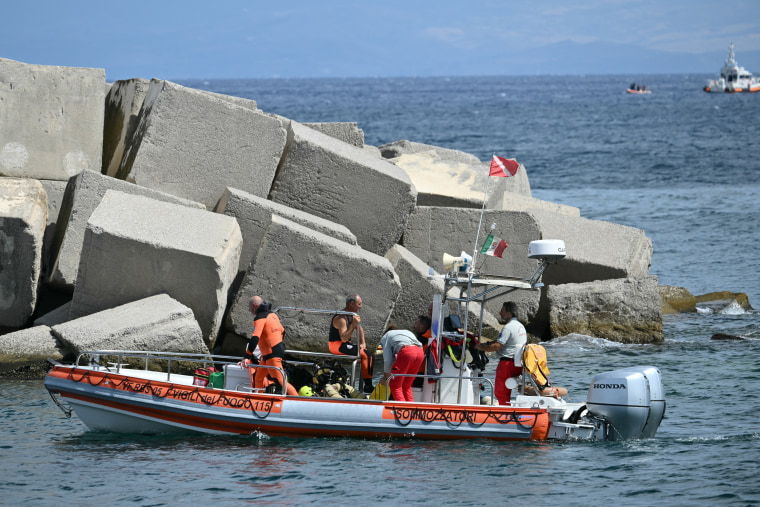
“It’s extremely rare for a boat of this size to sink,” Richter said.
What’s not rare is the kind of storm that sank it , said Simon Boxall, senior lecturer in oceanography at Britain’s University of Southampton.
“People assume the Mediterranean is this rather calm and passive place that never gets storms and always blue skies,” Boxall said. “In fact, you get some quite horrendous storms that are not uncommon at this time of year.”
The president of Italy’s meteorological society has said Monday’s violent storm may have involved a waterspout, essentially a tornado over water, or a downburst, which occurs more frequently but doesn’t involve the rotation of the air.
Luca Mercalli, president of the Italian Meteorology Society, also said recent temperatures may have been a factor.
“The sea surface temperature around Sicily was around 30 degrees Celsius [86 Fahrenheit], which is almost 3 degrees more than normal,” Mercalli told Reuters. “This creates an enormous source of energy that contributes to these storms.”
The Mediterranean sailing vacation was designed to be a celebration for Lynch, who two months ago was acquitted by a San Francisco jury of fraud charges stemming from the 2011 sale of his software company Autonomy to Hewlett-Packard for $11 billion.
Prosecutors alleged that Lynch, dubbed “Britain’s Bill Gates,” and Autonomy’s vice president for finance, Stephen Chamberlain, had padded the firm’s finances ahead of the sale. Lynch’s lawyers argued that HP was so eager to acquire Autonomy that it failed to adequately check the books .
Lynch had taken Morvill, who was one of his defense attorneys, on the luxury trip.
Chamberlain was not on the Bayesian.
In what appears to be a tragic coincidence, a car struck and killed Chamberlain on Saturday as he was jogging in a village about 68 miles north of London, local police said.
“Steve fought successfully to clear his good name at trial earlier this year, and his good name now lives on through his wonderful family,” Chamberlain’s lawyer, Gary Lincenberg, said in a statement .
Henry Austin reported from London and Corky Siemaszko from New York City.
Henry Austin is a senior editor for NBC News Digital based in London.
Corky Siemaszko is a senior reporter for NBC News Digital.
Superyacht sinks latest: Investigators reveal where bodies were found as probe looks at 'crew's responsibility'
Italian officials revealed at a news conference there could be "a question of manslaughter" as they opened a shipwreck investigation and said the probe is also looking at the "crew's responsibility".
Saturday 24 August 2024 18:33, UK
- Superyacht sinking
Please use Chrome browser for a more accessible video player
- Prosecutor: There 'could be a question of manslaughter'
- Probe 'concentrating' on crew's responsibility
- Seven bodies recovered after five-day search of superyacht wreckage off Sicily
- Saturday's papers pay tribute to youngest victim Hannah Lynch
- Hannah's sister pays tribute to 'my little angel'
- Explained: Inside the superyacht | What challenges have faced divers?
- Eyewitness: Sombre scenes greet rescue teams as final body is brought ashore
- Live reporting by Niamh Lynch
We're ending our live coverage for this evening but here is a recap of what we know:
- Prosecutors have opened a manslaughter investigation into the Bayesian sinking;
- Officials have revealed more details on their investigation and the difficult five-day rescue mission;
- The six bodies found during the search in recent days were all in cabins on the left-hand - and highest - side of the ship. Five were found in the first cabin and the sixth was found in the third;
- Prosecutors said the six passengers were most likely asleep when the boat sank;
- The probe is now focusing on the crew and their responsibilities, with the captain set to undergo more questioning.
Monday 19 August
The Bayesian yacht, flying a British flag, sinks at around 5am local time when the area was hit by a tornado.
Fifteen people are rescued from the 56 metre vessel - including a mother and baby - but another seven remain missing.
One body, later confirmed to be the yacht's chef Recaldo Thomas, is found near the wreck.
It emerges that British technology tycoon Mike Lynch and his 18-year-old daughter Hannah are among six people that remain missing.
Tuesday 20 August
The search continues for the six tourists missing.
It is reported that among those missing are Morgan Stanley International chairman Jonathan Bloomer; his wife, Judy Bloomer; Clifford Chance lawyer Chris Morvillo; and his wife, Neda Morvillo.
Police divers try to reach the hull of the ship, resting at a depth of 50 metres.
Italy's fire brigade Vigili del Fuoco say early inspections of the wreck were "unsuccessful" because of limited access to the bridge and furniture obstructing passages.
The operation is later described as "complex", with divers limited to 12-minute underwater shifts.
Tributes pour in for Mr Thomas, with his friend Gareth Williams saying: "I can talk for everyone that knew him when I say he was a well-loved, kind human being with a calm spirit."
Wednesday 21 August
The search for the six people unaccounted for enters a third day, with crews carrying out inspections of the yacht's internal hull.
A team of four British inspectors from the Marine Accident Investigation Branch (MAIB) arrive in Porticello to look at the site of the sinking.
A helicopter is drafted in to help with the search effort and remotely controlled underwater vehicles are being used, with naval units and cave divers also taking part in the search.
Five bodies are found inside the yacht on Wednesday afternoon. Only four of them are brought to shore.
Body bags are seen being taken to Porticello in the afternoon where dozens of emergency services staff wait.
Searches finish for the day just before 7.30pm.
Thursday 22 August
The search resumes for the remaining missing person.
The body of the fifth missing person, found but not recovered the previous day, is brought to shore.
A fire service boat with flashing blue lights returns with a blue body bag to the port of Porticello just after 8.45am local time on Thursday.
Tributes pour in for Mr Lynch and Mr and Mrs Bloomer after they are identified as having died.
The search is called off at around 8pm in Sicily, with divers expected to begin again at 6.30am on Friday.
Friday 23 August
The search continues for the final person missing from the wreck of the Bayesian, Hannah Lynch.
Vincenzo Zagarola, of the Italian Coastguard, says the search for Hannah has not been "easy or quick", comparing the sunken yacht to an "18-storey building full of water".
The coastguard confirms in the late morning that her body has been found.
A green body bag is brought to the port of Porticello from the site of the sinking.
A spokesperson announces on behalf of the Lynch family that they are "devastated" and "in shock" after the deaths of Mike and Hannah.
Hannah's sister Esme pays tribute to her "little angel".
Saturday 24 August
A press conference is held in the court of an Italian town, Termini Imerese.
Public prosecutor Ambrogio Cartosio tells reporters that his office has opened an initial investigation against unknown persons into manslaughter and negligent shipwreck.
As the focus now turns to the manslaughter investigation, here's another reminder of the seven victims of the sinking and the 15 people who survived.
A close friend of the Lynch family has added to the chorus of tributes for British tech tycoon Mike Lynch, who died in Monday's superyacht sinking.
Susannah Gurdun, who lives in Suffolk, recalled being "daunted" when she first met Mr Lynch at a dinner party, before discovering he was "so much more than the corporate cliche".
"He was riveting. He was funny, and kind, and endlessly interesting; capable of talking about anything and everything," she said.
Ms Gardun said the businessman also had a "thrilling ability" to make complicated subjects "accessible to those of us less blessed with a science acumen".
"In particular, he was wonderful with children. I will never forget hearing him explain to a group of them - including our ten year old son - the physics of why the sky went pink at sunset," she said.
She went on describe Mr Lynch as a "true genius" and "phenomenal creative".
Ms Gardun said his daughter Hannah was also showing "serious literary promise", and added that it was "beyond tragic that we will never know where her own particular brilliance might have led".
"I still feel blessed to have shared that time with them in Spain. Not just because I witnessed Mike’s incredible storytelling; but because I was given a chance of understanding what that moment said about all four of them as a united vibrant loving family," she said.
"He was an extraordinary human being and it was - truly - a privilege to have known him."
A yacht crew member who survived the sinking has paid tribute to Hannah Lynch, calling her a "diamond in a sea of stars".
Sasha Murray, chief stewardess of the Bayesian, has released a statement after divers recovered the final missing body from the wreckage, which is believed to be 18-year-old Hannah.
"Those who knew her will know that Hannah was a diamond in a sea of stars," she said.
"Bright, beautiful and always shining. What most people may not have seen was the extraordinarily strong, deep and loving relationship she shared with her parents, whom she adored more than anything.
"While swimming with them she often said, if anything ever happened she would save them.
"I have no doubt that the Irish, Latina fire that burns in her soul kept that spirited determination alive."
Ms Murray's statement comes as a new image of Hannah Lynch and her father Mike Lynch is released:
Prosecutors announced in this morning's news conference that they have opened a manslaughter and negligent shipwreck investigation.
Officials were unable to answer several queries from the media, saying they needed time to establish the facts, but what are the key questions facing prosecutors?
Why weren't passengers who remained on board the vessel warned about escaping from the yacht?
The prosecutor in charge of the case, Raffaele Cammarano, suggested that some passengers may have been asleep when others were awake.
Asked why they were not woken up or alerted, he said that is something investigators are trying to work out from the statements of the survivors.
He called it an "essential" part of the inquiry.
Why were several of the passengers in one cabin?
The press conference heard several bodies onboard the sunken yacht were found in a single cabin which was not theirs.
Mr Cammarano said investigators currently do not know the reason for them being discovered in the same cabin.
The chief of the Palermo fire service, Bentivoglio Fiandra, said the yacht pinned to the right and suggested people tried to go on the other side, taking refuge in cabins in the higher part of the wreck.
Why did the boat sink?
The vessel had been deemed "unsinkable" by its manufacturer - Italian shipyard Perini Navi.
The Bayesian was hit by a downburst, according to Mr Cammarano, which are powerful winds that descend from a thunderstorm and spread out quickly once they hit the ground.
Officials will look into the safety equipment on the sunken vessel.
Mr Cammarano was asked about whether there is a black box and if the hatches were left open.
He said investigators do not have exact information about the black box and that the first phase of the inquiry will look into it.
Why were nearby vessels not similarly affected?
Another yacht, the Sir Robert BP, was about 150 to 200 metres from the Bayesian when extreme weather hit.
Its crew helped to rescue 15 people from the stricken vessel.
Italian officials said they would be looking at how the downburst could affect one vehicle and not other nearby vessels.
What weather warnings was the Bayesian alerted to?
Maritime director of western Sicily, Rear Admiral Raffaele Macauda, said the weather at the time of the yacht's sinking was abnormal and there was nothing to suggest such an extreme situation would arise.
He said there were forecasts of winds and a storm alert, but there was no warning of a tornado.
"Given that the conditions were such, there wasn't anything to suggest there could be an extreme situation arising," he said.
"There are vessels that can monitor, after all, these events and one would have thought that the captain had taken precautions."
How long will it take to recover the sailing vessel?
Mr Macauda could not confirm how long it would take to retrieve the shipwreck of the sunken yacht.
"Everything depends on the availability of the owners and the timeframe of the retrieval of the wreck and of course all that has to be submitted to the port authorities and in parallel of course there will be the inquiry results and it's only really then that we will be able to authorise the operation," he said.
"I can't say, like some experts who have already spoken on the subject, [said] that it will be eight weeks."
He made clear that the owners will bear the full cost of retrieval, although he could not estimate the figure.
Italian authorities detailed the challenging and meticulous rescue operation to recover the six missing people from the Bayesian wreck (see 9.18am post).
But why was the five-day search so difficult?
Read more below...
More on this morning's press conference.
One of the main updates from prosecutors was that they have opened manslaughter and shipwreck investigations after the deaths of seven people in the Bayesian sinking.
Watch the announcement below...
Prosecutors have given a lengthy news conference this morning on their investigation into the sinking of the Bayesian.
Read the full report on the prosecutors' probe below...
Marine investigator James Wilkes has been speaking to Sky News after this morning's press conference.
"Naturally, there are more questions than there are substantive answers at the moment - that's the nature of investigative work.
"Something forced that yacht to roll beyond its nominal stability limits, such that it wasn't able to right itself with the ingress of a certain amount of seawater that was coming into the yacht.
"So the investigators are going to ask themselves one initial question - what must the conditions have been for this to happen?
"Then they are going to look at the contributing factors to the yacht, sinking, and, and the unfortunate loss of life."
Prosecutors said this morning that the future of the investigation is reliant on recovering the wreck.
Mr Wilkes said the yacht is a "major piece of physical evidence in and of itself."
"It's lying at 50 metres, which is a recoverable depth.
"If it was significantly deeper, then I'm not sure they'd be considering salvage at this stage or certainly, the salvage question would be a lot more complicated to answer.
"But if there was the ability to raise that yacht in one piece safely, then it gives the investigators physically more to look at."
Mr Wilkes said he was unsure if the yacht would have a "black box" - called a voyage data recorder in shipping.
"It would record things like GPS position, heading speed, engine telemetry, whether the radars were on, what they were recording, alarms, communications from the yacht itself, any audio on the bridge.
"But more often than not, these are on merchant ships. The yacht was a commercial yacht in the sense that it could be chartered out so it's quite possible it has a voyage data recorder on, but I'm not sure that it does. I don't know that as a matter of fact," he said.
Be the first to get Breaking News
Install the Sky News app for free

Advertisement
Supported by
Lynch Yacht Sinking Off Sicily Proves as Baffling as It Is Tragic
As bodies were recovered, the authorities and experts wondered how a $40 million, stable and secure vessel could have sunk so quickly.
- Share full article

By Emma Bubola and Michael J. de la Merced
Emma Bubola reported from Porticello, Italy, and Michael J. de la Merced from London.
Two months after being cleared in a bruising legal battle over fraud charges, the British tech mogul Mike Lynch celebrated his freedom with a cruise. He invited his family, friends and part of his legal team on board his luxury sailing yacht, a majestic 180-foot vessel named Bayesian after the mathematical theorem around which he had built his empire.
On Sunday night, after a tour of the Gulf of Naples, including Capri, and volcanic islands in the Eolian archipelago, the boat anchored half a mile off the Sicilian coast in Porticello, Italy. It chose a stretch of water favored by the Phoenicians thousands of years ago for its protection from the mistral wind and, in more recent times, by the yachts of tech billionaires. The boat was lit “like a Christmas tree,” local residents said, standing out against the full moon.
But about 4 a.m., calamity unfolded. A violent and fast storm hit the area with some of the strongest winds locals said they had ever felt. Fabio Cefalù, a fisherman, said he saw a flare pierce the darkness shortly after 4.
Minutes later, the yacht was underwater. Only dozens of cushions from the boat’s deck and a gigantic radar from its mast floated on the surface of the sea, fishermen said.
In all, 22 people were on board, 15 of whom were rescued. Six bodies — five passengers and the ship’s cook — had been recovered by Thursday afternoon, including that of Mr. Lynch, an Italian government official said, adding that the search was continuing for his daughter.
It was a tragic and mystifying turn of events for Mr. Lynch, 59, who had spent years seeking to clear his name and was finally inaugurating a new chapter in his life. Experts wondered how a $40 million yacht, so robust and stable could have been sunk by a storm near a port within minutes.
“It drives me insane,” said Giovanni Costantino, the chief executive of the Italian Sea Group, which in 2022 bought the company, Perini, that made the Bayesian. “Following all the proper procedures, that boat is unsinkable.”
The aura of misfortune only deepened when it emerged that Stephen Chamberlain, 52, a former vice president of finance for Mr. Lynch’s former company and a co-defendant in the fraud case, was killed two days earlier, when he was hit by a car while jogging near his house in England.
Since June, the two men had been in a jubilant mood. A jury in San Francisco had acquitted both on fraud charges that could have sent them to prison for two decades. There were hugs and tears, and they and their legal teams went for a celebratory dinner party at a restaurant in the city, said Gary S. Lincenberg, a lawyer for Mr. Chamberlain.
The sea excursion was meant as a thank-you by Mr. Lynch to those who had helped him in his legal travails. Among the guests was Christopher J. Morvillo, 59, a scion of a prominent New York family of lawyers who had represented Mr. Lynch for 12 years. He and his wife, Neda, 57, were among the missing.
So, too, was Jonathan Bloomer, 70, a veteran British insurance executive who chaired Morgan Stanley International and the insurer Hiscox.
The body of the ship’s cook, Recaldo Thomas, was recovered. All the other crew members survived. Among them was Leo Eppel, 19, of South Africa, who was on his first yacht voyage working as a deck steward, said a friend, who asked not to be identified.
Since the sinking, the recovery effort and investigation have turned the tiny port town of Porticello, a quiet enclave where older men sit bare-chested on balconies, into what feels like the set of a movie.
Helicopters have flown overhead. Ambulances have sped by with the sirens blaring. The Coast Guard has patrolled the waters off shore, within sight of a cordoned-off dock that had been turned into an emergency headquarters.
On Wednesday afternoon, a church bell tolled after the first body bag was loaded into an ambulance, a crowd watching in silence.
The survivors were sheltering in a sprawling resort near Porticello, with a view of the shipwreck spot, and had so far declined to comment.
Attilio Di Diodato, director of the Italian Air Force’s Center for Aerospace Meteorology and Climatology, said that the yacht had most likely been hit by a fierce “down burst” — when air generated within a thunderstorm descends rapidly — or by a waterspout , similar to a tornado over water.
He added that his agency had put out rough-sea warnings the previous evening, alerting sailors about storms and strong winds. Locals said the winds “felt like an earthquake.”
Mr. Costantino, the boat executive, said the yacht had been specifically designed for having a tall mast — the second-tallest aluminum mast in the world. He said the Bayesian was an extremely safe and secure boat that could list even to 75 degrees without capsizing.
But he said that if some of the hatches on the side and in the stern, or some of the deck doors, had been open, the boat could have taken on water and sunk. Standard procedure in such storms, he said, is to switch on the engine, lift the anchor and turn the boat into the wind, lowering the keel for extra stability, closing doors and gathering the guests in the main hall inside the deck.

12 guests occupied the yacht’s six cabins. There were also 10 crew members.
Open hatches, doors and cabin windows could have let in water during a storm, according to the manufacturer.

Open hatches, doors and
cabin windows could
have let in water
during a storm,
according to the
manufacturer.
Source: Superyacht Times, YachtCharterFleet, MarineTraffic
By Veronica Penney
The New York Times attempted to reach the captain, James Cutfield, who had survived, for comment through social media, his brother and the management company of the yacht (which did not hire the crew), but did not make contact.
So far none of the surviving crew members have made a public statement about what happened that night.
Fabio Genco, the director of Palermo’s emergency services, who treated some of the survivors, said that the victims had recounted feeling as if the boat was being lifted, then suddenly dropped, with objects from the cabins falling on them.
The Italian Coast Guard said it had deployed a remotely operated vehicle that can prowl underwater for up to seven hours at a depth of more than 980 feet and record videos and images that they hoped would help them reconstruct the dynamics of the sinking. Such devices were used during the search and rescue operations of the Titan vessel that is believed to have imploded last summer near the wreckage of the Titanic.
After rescuers broke inside the yacht, they struggled to navigate the ropes and many pieces of furniture cluttering the vessel, said Luca Cari, a spokesman for Italy’s national firefighter corps.
Finally, as of Thursday morning, they had managed to retrieve all but one of the missing bodies, and hopes of finding the missing person alive were thin. “Can a human being be underwater for two days?” Mr. Cari asked.
What was certain was that Mr. Lynch’s death was yet another cruel twist of fate for a man who had spent years seeking to clear his name.
He earned a fortune in technology and was nicknamed Britain’s Bill Gates. But for more than a decade, he had been treated as anything but a respected tech leader.
He was accused by Hewlett-Packard, the American technological pioneer that had bought his software company, Autonomy, for $11 billion, of misleading it about his company’s worth. (Hewlett-Packard wrote down the value of the transaction by about $8.8 billion, and critics called it one of the worst deals of all time .) He had been increasingly shunned by the British establishment that he sought to break into after growing up working-class outside London.
He was extradited to San Francisco to face criminal charges, and confined to house arrest and 24-hour surveillance on his dime. In a townhouse in the Pacific Heights neighborhood — with security people he jokingly told associates were his “roommates” — he spent his mornings talking with researchers whom he funded personally on new applications for artificial intelligence. Afterward, he devoted hours to discussing legal strategy with his team.
Despite his persistent claims of innocence, even those close to Mr. Lynch had believed his odds of victory were slim. Autonomy’s chief financial officer, Sushovan Hussain, was convicted in 2018 of similar fraud charges and spent five years in prison.
During Mr. Lynch’s house arrest, his brother and mother died. His wife, Angela Bacares, frequently flew over from England, and she became a constant presence in the San Francisco courtroom during the trial.
After he was finally acquitted, Mr. Lynch had his eye on the future. “I am looking forward to returning to the U.K. and getting back to what I love most: my family and innovating in my field,” he said.
Elisabetta Povoledo contributed reporting from Pallanza, Italy.
Emma Bubola is a Times reporter based in Rome. More about Emma Bubola
Michael J. de la Merced has covered global business and finance news for The Times since 2006. More about Michael J. de la Merced
How To Learn To Sail: Ultimate Step-By-Step Guide
Getting into sailing can seem daunting. When I first got interested, I was completely overwhelmed by all the skills, conflicting information, - and man oh man - all those insider terms. If you don't know where to start, it can be very confusing.
How to learn to sail? When first starting out, you want to gain some experience on the water, learn basic sail trim and navigation, and learn the basic safety rules. You can learn this by taking online courses, and by taking sailing lessons. With the right approach, you could get up to speed in a couple of months and for as little as $500.
Learning from my own experience, I wanted to create a very easy-to-understand guide which walks you through everything you'll need to know and learn when first starting out. In this guide, I'll walk you through all the different aspects of sailing: what to expect (ie. costs), what skills you'll need and how to learn those, and what knowledge you'll need and where to find it.
Spoiler : it's cheaper and easier to learn than you would expect.
Over the last few years, I have written on a lot of different aspects of getting into sailing. Throughout this guide, I will regularly refer to specific articles where you can learn more on a specific topic. This guide is a jumping-off point you can use to quickly get up to speed, and dive in deeper on a particular topic whenever you feel like it.
As a result, it is a long article with lots of information; it may be too much to read all in one sitting. The upside is: it's all here. I recommend bookmarking this article and coming back to it every now and then and pick up where you've left. Let's get started.

On this page:
How to get into sailing, myths that could be holding you back, how to get started, skills you need to learn to sail, things you'll need, in conclusion.

Sailing is both a practical and theoretical skill. You really should gain real-life experience, but you can also learn a lot of essential skills by reading up on them. Let me quickly walk you through my recommendation of how to getting into sailing.
7 easy steps to get into sailing:
- Focus on learning the theory first, focus on practice second
- The essential sailing skills are sail trim, navigation, and boat safety
- Start out using (free) online resources or Sailaway simulator
- After that, gain experience by taking at least a couple of sailing lessons
- To cut cost, you could also crew for an experienced captain instead
- Get your boater's license if necessary
- Hire a boat at first to cut cost and figure out what you like
By first focusing on the theory, which you can mostly do using free resources (and this website), you save on those valuable sailing lessons.
I'll break down all of these steps later. But now, we first have to talk about some common misconceptions about sailing, what it costs, and how long it takes before you sail your first boat by yourself. It's sooner than you might think.

Sailing is known to be an elite sport that costs way too much money. It's hard to learn, expensive to do, and you need all kinds of special knowledge - right? Well, all of those things can absolutely be true, if you want them to be. But sailing has always been one of the cheapest ways of transportation and can be quite easy to learn. I had a ton of those common misconceptions myself, and they were keeping me back. Maybe some of those are holding you back too?
Let me tell you some secrets that will probably change the way you think about the timeline of your sailing dream.
Sailing can be an affordable hobby
- A realistic budget for beginner sailors is $100 - $300 per month
- If you want to, you can get a decent education for as little as $500
- A decent beginner sailboat can cost between $200 - $2,000
In order to sail, you need some things that potentially cost a lot of money:
- a sailboat (preferably a 52' superyacht, right?)
- sailing lessons (and probably tons of them, right?)
- speciality gear like navigation equipment (you can't use regular water bottles, right?)
I say potentially because it really doesn't have to be that way. Sailing can be a normal hobby for regular people that have normal budgets.
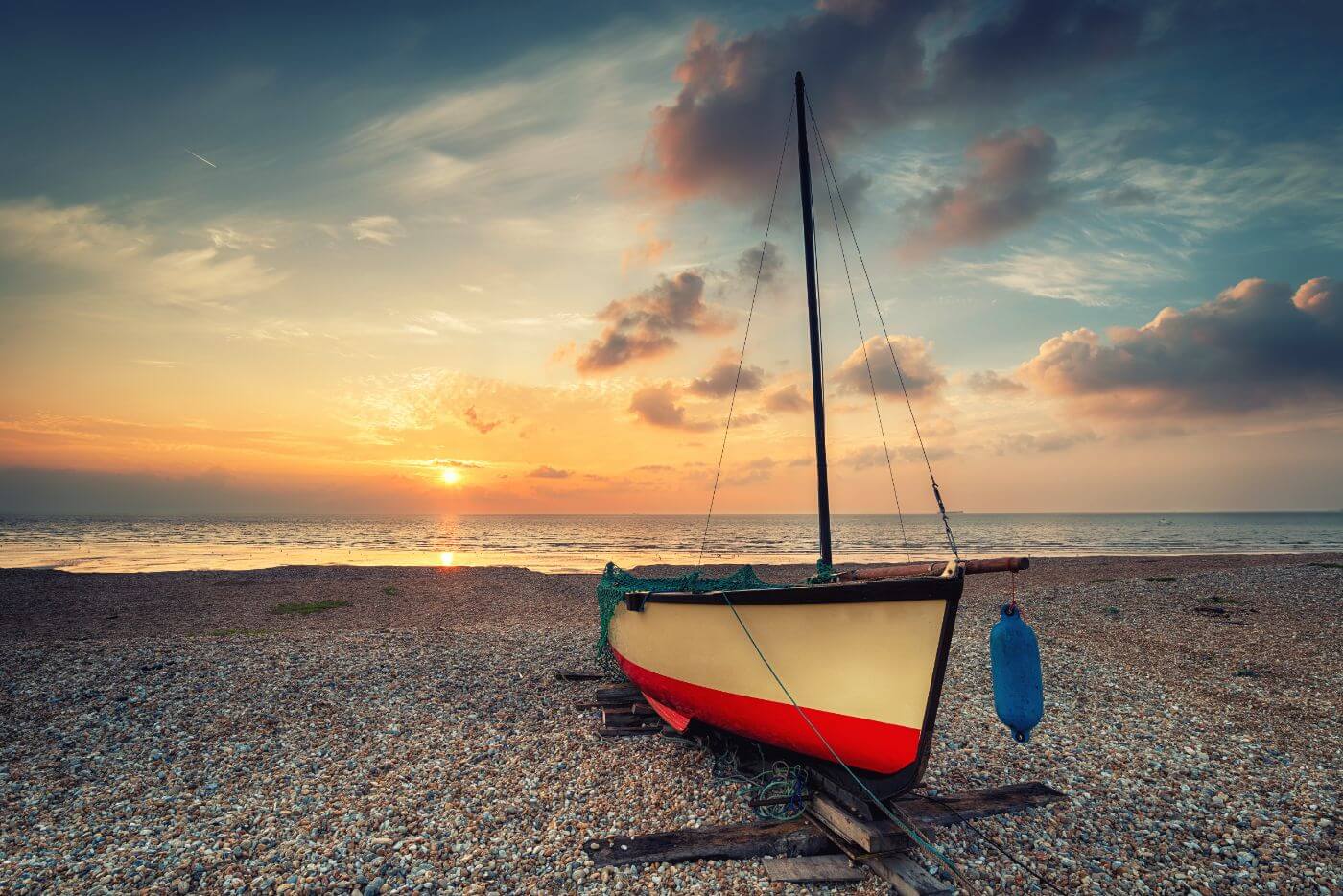
Sure, you can spend tons of money on gear and lessons, as with any hobby. You can get yourself special sailing water bottles that provide more optimal water disposal flow in marine environments. You can buy a world-cruising yacht. But let's be fair: you don't own a plane (if you do, call me), yet you are able to fly to nearly every place on Earth if you want to. If you prioritize, you actually don't need all that much gear ór lessons.
In most states and countries, you actually don't even need an official education in order to sail smaller boats. I do recommend getting some training in advance. But you can really get a super decent training and tons of experience on just a $500 budget .
Want to get into sailing on a budget? I've written a detailed guide on how to learn the most important sailing skills on less than $500 . There are tips in there that cost absolutely nothing and are very good first steps.

9 Ways to Learn to Sail for (Practically) Free
A realistic starting budget is $100 - $300.
I've done research on the costs of all different aspects of sailing and I was surprised by the results. You could sail on any budget really, depending on how creative you want to get. $0 is possible but it takes work, patience, and luck. For most people, a realistic budget to get started is between $100 - $300 per month. That will allow you to hire a boat a couple of days per month, get some training, buy some gear, and eventually buy your first sailboat.
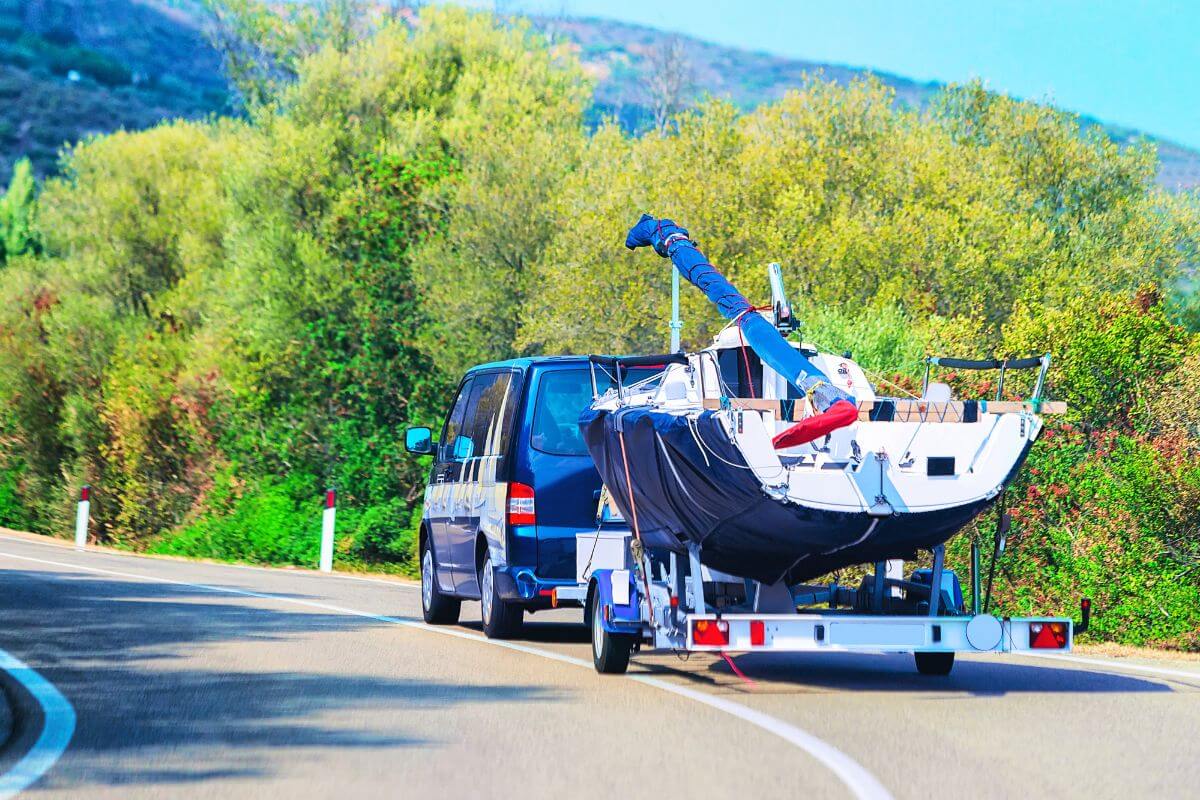
There are affordable beginner sailboats out there
Buying a boat will always cost money, but there are so many second-hand sailboats you can always find a decent deal, or even a free learning boat, as long as you don't immediately want to go out and get yourself a yacht.
In fact, you probably want to consider buying a very small beginner laser to start out. The smaller the boat, the faster you'll learn. Small, light sailboats give you faster and more precise feedback on what you do. And small lasers are pretty inexpensive. You can get good second-hand deals for just a couple of hundred bucks. This also means you can put them on a trailer and store them at home. Saves additional cost. Larger sailboats (22ft and up) get very expensive very quickly, though.

The Average Cost of Buying & Owning a Sailboat I have compared thousands of sailboat prices, and the cost of ownership. In this guide, we'll go over every dollar it will cost to own a boat . If you are unsure what it costs to buy and own a boat (and what's possible on your budget), this is a great resource for you.
But there's more cash-saving good news: you don't necessarily need to own a boat to get started.
You don't need to own a boat to get started
Hiring a boat is pretty straightforward nowadays, and more and more private owners are renting out there boat for fair prices on platforms like Boatsetter (Airbnb for boats). So when first starting out, I recommend renting a sailboat for a couple of weekends first, which should get you a good feel for the whole thing.

You can set sail within a couple of months
Learning to sail can take anywhere between 50 - 500 hours, depending on what level of skill you require. Coastal sailing and ocean passages require a lot more knowledge and experience. In contrast, you can learn to sail your recreational lake in light winds pretty quickly.
You can get started today
It's okay to not be the best sailor straight away. As with any skill worth learning, it's worth doing badly at first. As long as you don't get in anybody's way and stay safe, you can try and fail all you want. That's great because it means you can start today. You don't need hundreds of lessons before setting out on your own.
Some people like to pretend sailing is some mysterious superpower. Sure, doing something really well is always hard, and so is sailing really well. But in the end, we're just catching wind with a piece of cloth. Let's not make it harder than it is.

You probably don't even need a license
In some states, you don't need any licenses in order to sail your boat in inland waters. Most states only require you to take a short boater safety exam, which you can do online for roughly $50. After that, you're officially good to go. If you don't require to get a safety license, I still recommend getting one. It's so cheap and easy to get, and it's better to be safe than sorry.
I do recommend getting some basic training before hitting the waters, as operating a boat can be nerve-racking if you're new, and it's just safer if you know the basic rules of the road. More on how to do that later.
For coastal and international waters, you do need multiple licenses, which will take money and time to pass. But when first starting out, you probably want to gain a lot of experience on small bodies of water first.

Okay, so apparently you don't need a huge budget, you don't need dozens of licenses, and you don't need hundreds of lessons before sailing your first boat. You can start today, and nothing's holding you back - you probably get that by now. Except, something is holding you back. Where the heck do you start?
Well, let's start with learning the essential skills before doing anything else.
I have written a very simple approach to learn to sail for practically free (I have linked to it before). Besides being cheap, it's also a good overview of how to go about learning these essential skills. Here's the gist of it:
My 5-step bootstrap plan for new sailors
1. lay the theoretic groundwork.
- Start with free online introductory courses
- Read up on the essential knowledge on Improve Sailing
- Spend time playing Sailaway Sailing Simulator
- Read my recommendation for free courses here .
2. Test where you stand
Now that you have some theoretic knowledge, take two sailing lessons to test where you stand. Don't go overboard on lessons, just get a feel for how quick you learn and how much you know (or don't) already. That way, you don't break the bank and can change your plan accordingly.
3. Gain experience
Next, we want to make sure we have enough experience to stay safe and confident.
- If you are a quick learner , take a 1 or 2-day sailing course. This is a bit more expensive, but it pays off to spend a longer time with someone experienced.
- If you feel like you need more help at first, I recommend trying to become a ship's mate first. This is free and you learn a lot quickly. You can be a ship's mate for a day, a week, or an entire season.

4. Optional: get your license
If you need any licenses, be sure to get them now. In most states, you just need to take a basic boater's safety exam .
5. Set sail
Once you have the basic theoretic knowledge and practical experience, you can finally set sail on your own. I suggest hiring (chartering) a boat at first. This doesn't have to be expensive at all and is a great way to learn what you like and dislike.
General tips when setting sail for the first time
- Start with small boats (under 24') for better feedback
- Sail with light winds of 7 knots or less
- Start small and work your way up
- Safety is always your priority, speed comes second
Let's take a look at the precise skills you need to develop in order to become a good sailor. Below is a quick overview of essential skills and important information, and I'll link to which articles will help you out.

Essential sailing skills
- Marine navigation
- Weather interpretation
If you learn the fundamentals of these five skills, you should be able to stay safe while navigating through most situations. We'll walk through each of those skills, what it involves, and how to learn it below.
Other useful skills that are not essential at first are general boat maintenance, diagnosing electrical issues, and maintaining your boat's engine.
How to learn basic sailing skills
I recommend reading up on basic sailing skills. We have created a special page that shows you what articles we recommend when first starting out . Reading up on sailing skills might seem unnesseccary, but believe me, it really helps to boost your confidence if you have read about all those moving parts ahead of time. It will also save you precious lesson time.
NauticEd offers Basic Sail Trim as one of their free introductory courses , so I recommend taking that course, as well as playing Sailaway, which will really prepare you for trimming sails in real life.
Here's a great beginner sail trim video:
The most important way to learn basic sailing skills, of course, is going out and practising them on the water. I would want to have at least a basic grasp of sail trim and navigation before sailing single-handed (alone).
How to learn marine navigation
I recently wrote a complete guide on how to learn marine navigation . I suggest you start there - it's a very comprehensive guide and great for beginners. I specifically wrote it for people who don't know where to start. In it, I explain the fundamentals and link out to more in-depth articles, so you can explore on your own. Marine navigation is a skill you can train at home especially well.
How to learn anchoring
This is more of a practical skill, but I still recommend to read up on it first (it doesn't cost you anything). William has written a couple of solid articles on anchoring:
- 9 Easy Expert Tips for Anchoring a Boat Near Shore
- How Much Anchor Chain Should You Let Out When Anchoring?
- Can I Moor & Anchor My Boat Anywhere?
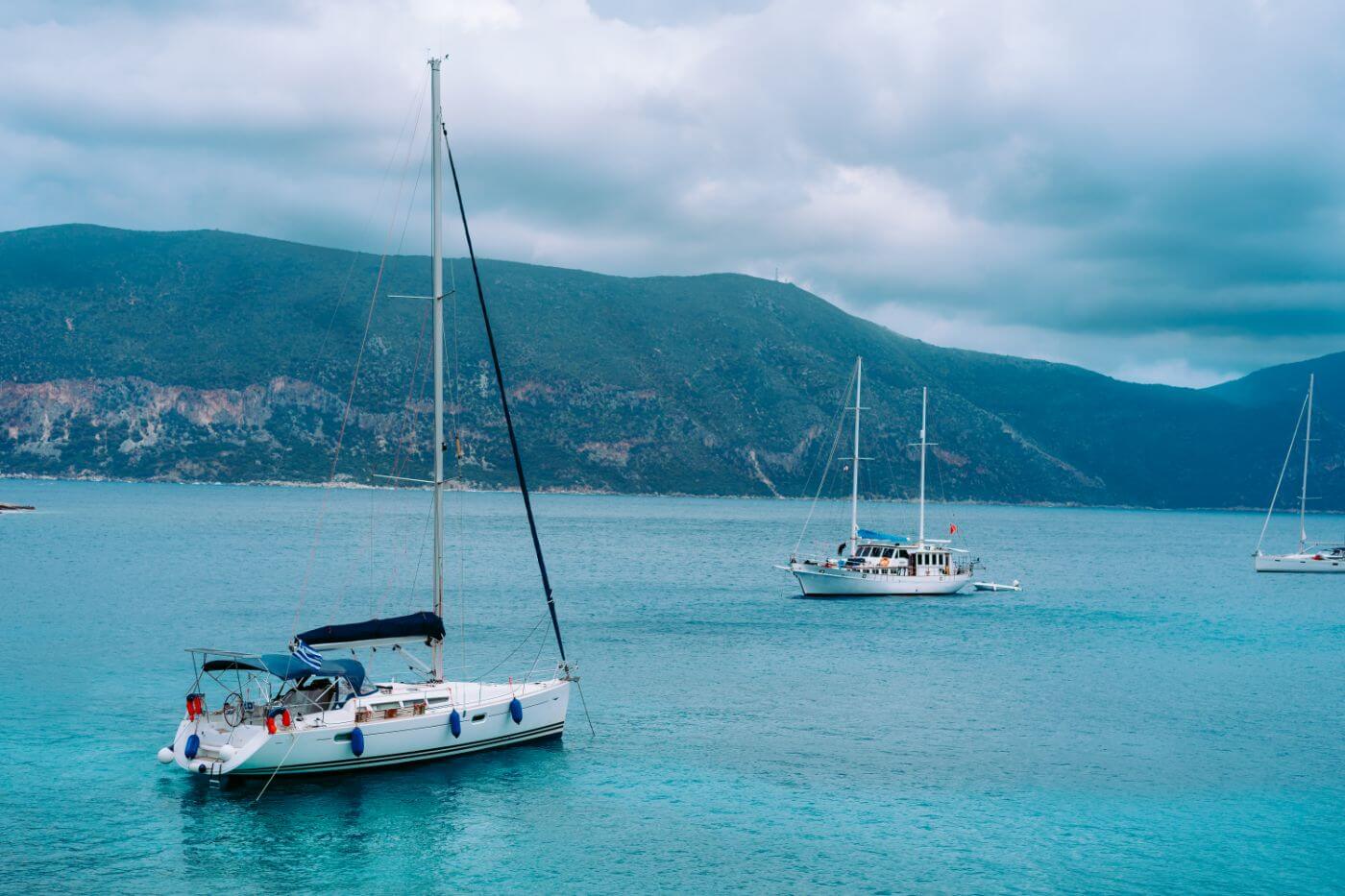
Essential knowledge
Even though sailing is a very hands-on skill, you do need some theoretical knowledge as well.
- Boat Safety Standards
- Rules of the Road - essential in avoiding collisions and dangerous situations
This information is included in one of the free introductory courses offered by NauticEd , and I believe ASA also has a free course on collision rules.
Useful knowledge

Besides this essential information, there are also things that are simply handy to know. It really pays to invest some time into learning the most important sailing terms. I recommend you learn the following at the least:
- Basic parts of sailboats - has great diagrams
- Basic sail names - illustrated guide with examples
- Most common sailing terms - extensive database
Understanding the basic names of things comes in handy when shouting orders at your crew (or being shouted at!), and avoiding any confusion. However, you can definitely sail a boat without knowing the name of everything on it.
There is some basic gear you probably want to have as a first-time sailor. Luckily, there isn't a lot of speciality stuff you have to have when renting your first sailboat.
- suitable shoes & clothing
- basic navigation tools
- optional: plotting tools
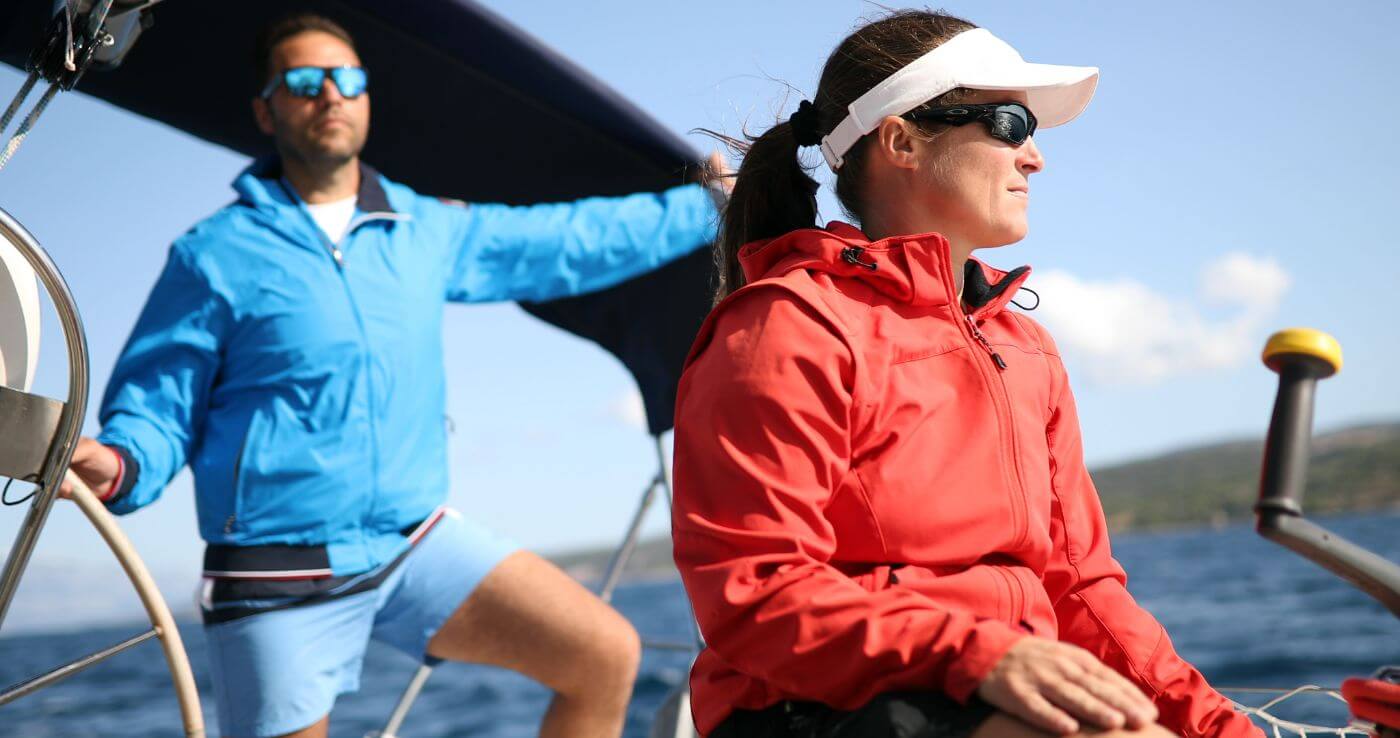
Suitable shoes
If you're just going out sailing for some odd days here and there, you only need suitable shoes to wear onboard. Or you could not wear any shoes at all, which is cheaper obviously. It can pay off to invest in something to protect your pinky toe.
- Here's What Shoes to Wear Sailing (and which not )
Sailing gloves
If you're planning on sailing more often, or longer days, you might want to consider getting a good pair of sailing gloves. Those will really help protect your hands from fatigue, blisters, and rope burn.
I highly recommend getting some kind of headwear. Make sure it has a strap or is a tight fit. Protecting yourself from the sun is important on the water. You get sunburn quickly.
Suitable clothing
You can wear regular clothing. Make sure to bring multiple layers, as temperatures on the water can change quickly. If you have clothes that are lightweight, comfortable, dry quickly, and optionally break wind, that's perfect. You could of course buy special sailing jackets, but these tend to be pricey, and you only really need them if you're on the water a lot.
Here's an expert tip: always bring dry clothes and wrap them in a plastic bag.
- Here's What to Wear Sailing in the UK
If you're looking for good quality sailing gear, I have articles on gear I like. You can check them out on the recommended gear section of this site. It has all the sailing gear I love most.
Navigation tools
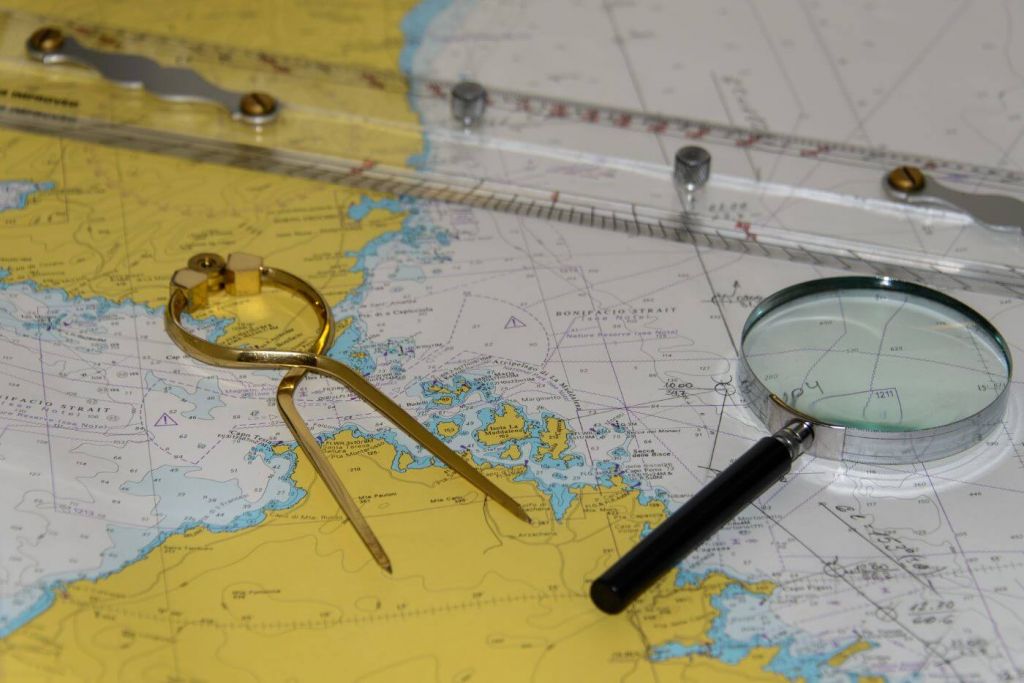
When renting a boat, you want to bring some basic navigational tools:
- handheld magnetic compass
- nautical charts
Most people won't need plotting tools at first, but if you're planning on sailing longer legs, you might want to get them:
- parallel rulers
You might also need to show your skipper's license, or at least your boater's safety license.
Getting into sailing doesn't have to be complex at all. If you bookmark this article, you can get back to it (and the resources I link out to) and work your way through them in your own time. Taking your time to learn the fundamentals right first will greatly speed up your practical learning experience.
While sailing is a practical skill, and more traditional skippers will argue that you can't learn it on paper, I disagree. There is a lot of information that is especially suited to learn online or practice at home. By doing so, you'll feel more confident once you set foot on board. However, you probably shouldn't postpone bolstering your practical experience either. You want to see where you stand as quickly as possible. A lot of people put it off indefinitely, and if there's one thing true about the internet - actually, two -, it is this:
- You can keep reading indefinitely.
- It can't replace the real thing.
Instead, use it as a helpful resource to speed up the process and cut cost. It's a great place to do homework. But now, it's time to step aboard - good luck, and smooth sailing!
Leave a comment

How to Keep a Small Sailboat from Capsizing…and what to do if it does
By John McCabe

Keeping weight to windward and the centerboard (or daggerboard) fully lowered will reduce the boat’s tendency to capsize in a breeze. Photo courtesy of Rick Bannerot/OntheFlyPhoto.net
On my second date with a young lady in the early 1960s, she and I were sailing on a 19-foot Lightning on the Navesink River in New Jersey. The weather was picture-perfect, and my date was all dressed up for a day on the water. I was at the tiller. At some point I had to announce calmly that we were going to capsize. Reflecting back on what she heard, she recalls that she had a couple of seconds to think about what that meant, then, suddenly, she was up to her neck in the water. It all worked out OK though – we’ll soon be celebrating our 50th wedding anniversary! I have had the opportunity to be on a number of boats since then and have learned some important lessons on how to keep a small sailboat from capsizing and what to do if it does.
Have in mind that any sailboat can capsize, but let’s describe what “capsize” means. The mainsail prevents most boats from going over more than 90 degrees – at least for a short time. The mast, if made of metal, is hollow, and the air in the mast will keep it afloat, at least until it fills with water. With a sailboat with a fixed keel, the weight of the keel will right the boat more or less fairly soon. While sailing with a centerboard, the board will inhibit the boat from capsizing and like a keel, will push the boat forward when the wind hits the boat at an angle, rather than moving the boat directly sideways. When a sailboat has its centerboard down, the boat will be less likely to capsize, but if it does, the centerboard will help. With a little effort the centerboard will indeed help right the boat as discussed below.
What causes a small sailboat to capsize? It is often the misalignment of weight, not just the wind. Indeed, even in light wind, if the weight is misaligned, the boat can tip over. Weight sources are people and importantly the boom! When the weight of people is on one side, the tipping of the boat will cause the boom to move to that side by the force of gravity, not necessarily the wind. Indeed, in light winds the force of gravity on the boom can have a greater effect on the position of the boom than the force of the wind! Thus, in light air there is still the potential of capsizing if both the weight of people and boom are on one side. This brings us to the first rule that must be followed:
Rule 1: The centerboard must be fully down at all times when a sail is up.
Now, there may be times with the boat goes aground. For a keelboat, you can put the motor in reverse as strong as possible to see if the boat can be backed out of the mud or sand. At the same time you can try to rock the boat. For a small sailboat with the centerboard down, you can try to use the motor. Preferably, however, you should use an oar to push off from the bottom or oars to row off the bottom. The outboard motor propeller, if made of plastic, is meant to break if it hits a rock or a hard bottom. At this point, it is very tempting to raise the centerboard a few inches to loosen the boat from the bottom. But do not do this – you risk capsizing! First, take the sail down. Then maneuver the boat off the bottom using the oars, motor or other method. Again, fully lower the sail before raising the centerboard even an inch. Note Rule 1, above.
Rule 2: Don’t stand up in a small sailboat when underway.
This rule helps in weight distribution in as least three ways. First, because of the boom, it may be harder to move your body to the correct location on the boat, and second, if the boom, because of gravity or the wind, hits your body (hopefully not your head), it reinforces the force to capsize the boat at a higher center of gravity. Third, if your body or head is at or above the level of the boom, the boom cannot move to let the air out of the mainsail. This exacerbates the force that will tip the boat. Note that standing up is not the sole factor that can cause a boat to capsize, but it can be a contributing factor. At all times, keep low and be prepared to uncleat the mainsheet and let the sail out. Be prepared to shift weight rapidly if necessary, but otherwise keep a low profile and move slowly. In summary, don’t stand up in a small sailboat, except perhaps while boarding.
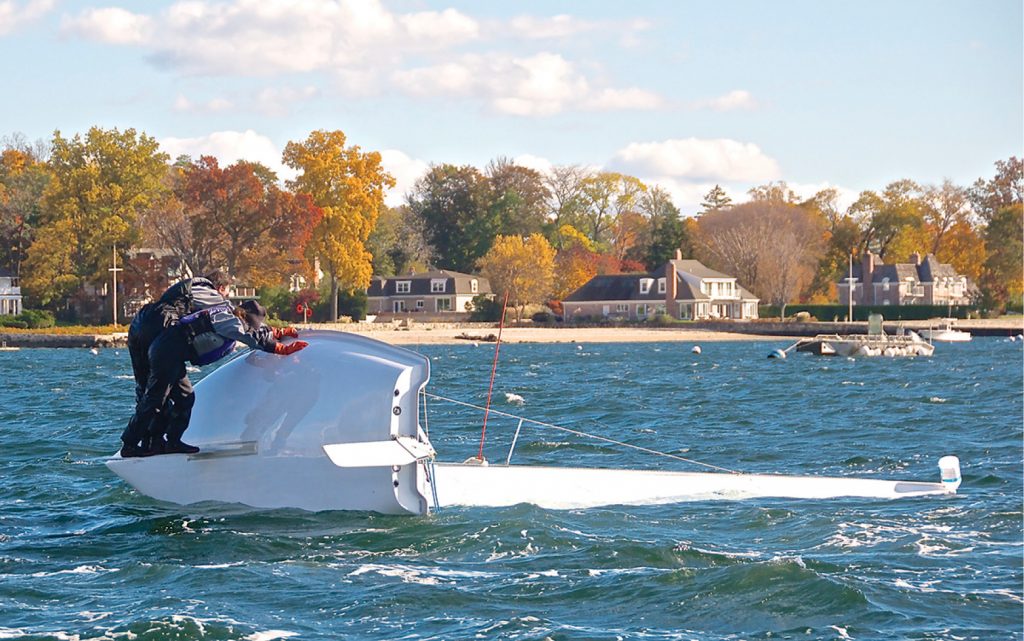
If you’ve capsized, climb onto the centerboard, grab the rail and use your weight to lever the boat upright. Note the empty 1-gallon bottle tied to the masthead, which helps prevent the boat from turning turtle. Photo courtesy of Rick Bannerot/OntheFlyPhoto.net
Rule 3: Be prepared at all times to let out the mainsheet or turn into the wind, or both, in moderate or heavy winds.
The recommendation here is the sailors should at all times know where the wind is coming from, its force, and where your boat is in relation to the wind. Keep your hand on the mainsheet so that it can be loosened and readjusted easily at any time. Also, keep your hand on the tiller so that the direction of the boat can be adjusted promptly. At all times be prepared to unclog the main sheet and let the sail out. Also, when do you reef the main sail? As soon as you think of it! – old sailor wisdom. Note that the farther the boom and sail are let out the more weight is put toward the side where the boom is located. But, ironically, you should let the sail out because it will catch less wind! Let it out a little or a lot, in your judgment. Alternatively, turn the boat into the wind. The preferred approach is to choose your direction, and then adjust the sails to achieve that direction, if possible.

Once you are on a tack in a small boat, do not jibe (change direction by turning in the direction the wind is blowing towards) except in light winds because you risk capsizing. Always “come about” (turn in the direction the wind is coming from) and call out in a strong enough voice “COMING ABOUT!” so all on board know what is happening and can change their position to be on the windward side of the boat. You can also say, “hard to lee” meaning the tiller is moved quickly and fully to the leeward side of the boat (in the direction the wind is blowing toward) forcing the boat to turn into the wind. Always have the mainsheet in hand, and I would suggest wearing gloves. Gloves also keep the sailor’s hands from getting sunburned, an added benefit. In summary, when at risk for capsize, let out the mainsheet and/or turn into wind. Preferably, let out the mainsheet.
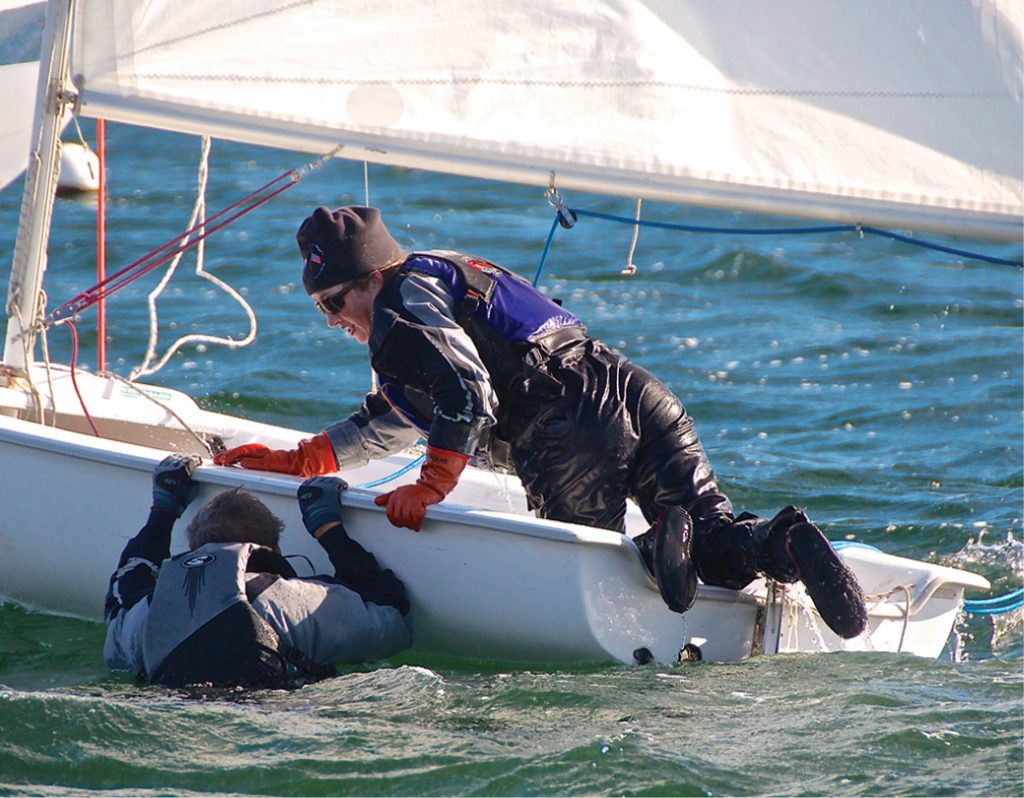
Climb back aboard from the bow or stern. Attempting to board from the side may cause the boat to flip again. Photo courtesy of Rick Bannerot/OntheFlyPhoto.net
Rule 4: On a small sailboat, do not use the motor when the sail is up.
This rule may surprise some sailors. In a larger boat with a keel, you need to turn the motor on before bringing down the main sail because you will have no control over the boat direction when there are no sails up. On the other hand, in a small centerboard sailboat, if the motor is on and the crew is in the process of taking down the sails there is a risk of capsizing while the motor is in gear. This is dangerous because the prop will continue to turn even with the boat turned over 90 degrees. That presents a risk to those who may at that point be in the water. Understand that the motor can keep running if the boat capsizes unless it is shut off either by twisting the handle or using a magnetic disk release (See Rule 5). On a small sailboat, the motor must be off when taking the sails down. The boat will naturally head into the wind if the tiller is let go.
Rule 5: Use a magnetic disk engine shutoff and wristband when two or more people are on the boat.
Some electric outboard motors have a magnetic disk and a pad that will shut the motor off when and if the magnetic disk is separated from the pad. The magnetic disk has a wristband that may be used by the operator holding the tiller on the outboard. It is a good idea to use this wristband when underway with the outboard in gear. This is particularly true when there are two or more individuals on board a small boat. Again, if the boat capsizes or there is a man overboard, the motor will continue to run and the propeller turn unless the motor is shut off. This may be hard to do in an urgent situation or if a sudden, unexpected event occurs.
What to do if the small sailboat capsizes
A small sailboat may capsize, but it can be expected to turn over initially not more than about 90 degrees. This is enough to fill the boat with water and if left in that position, the mast may go down further in the water making the challenge of righting the boat more difficult. Accordingly, if the boat capsizes, take the following steps as quickly as possible:
- Account for all who were on board. Grab the lifejackets and put them on. Of course, make sure the life jackets are easily accessible before departure. [Better still, put them on before leaving the dock – Ed.] For inexperienced passengers, make sure their lifejackets are on before putting on your lifejacket. Of course, children 12 and under must wear lifejackets at all times. Always have lifejackets on board for all persons on board. An extra lifejacket can be tied to or placed on the top of the mast, which will keep the mast from sinking further into the water.
- Swim to the bottom side of the boat and stand on the centerboard, grabbing the rail until the boat rights itself. The boat will still be full of water, but it’s unlikely to sink. The water may even be at a level that is slightly below the edges of the coamings. However, water may be sloshing in and out of the boat at this time.
- Then enter the boat from either the bow or the stern – not the side. The bow will usually be better as the weight on the bow will not result in lowering the cockpit below the waterline and the motor in the back represents weight there. Hopefully, if there is a hole in the stern for the tiller, that hole will be moved above the waterline. The boat will float but it can still take on water. If’t is easier to board the boat from the stern, that’s OK too.
- Once in the cockpit, grab a bucket placed in the boat earlier (note boat inventory list below). Then, move to the forward side of cockpit to sit and bail. Why? The hole in the stern for the rudder will let in water and you may prevent this by being in the forward end of the cockpit. The tiller should be free, and the boat will normally point into the wind. Next, lower the sails if you can in this timeframe.
- The best position to sit when bailing out the boat is the forward portion of the cockpit, i.e., towards the bow. The crew member in the cockpit should place his or her back against the front of the cockpit (bow end of the coaming). If a second person is present, he or she should be in water at the bow to hold down the bow. Positioning the boat like a banana will aid in the bailout. Using the bucket, the crew member in the cockpit should bail the water out of the cockpit furiously in the beginning, until the water in the boat is at a level that he or she can bail at a more comfortable pace. It is quite feasible to remove 100% of the water from the boat using a combination of the bucket, a hand bilge pump and a sponge. When most of the water is out of the boat, a crew member in the water can enter the boat from the stern (not the side), being careful not to tip the boat over again.
- Wave for help if necessary. Also, if possible, a “Mayday” can be sent on VHF channel 16, monitored by the U.S. Coast Guard, or call 911 on your cell phone. Hopefully, the sail can be hoisted again and the boat can proceed to its destination.
Small Boat Inventory Checklist
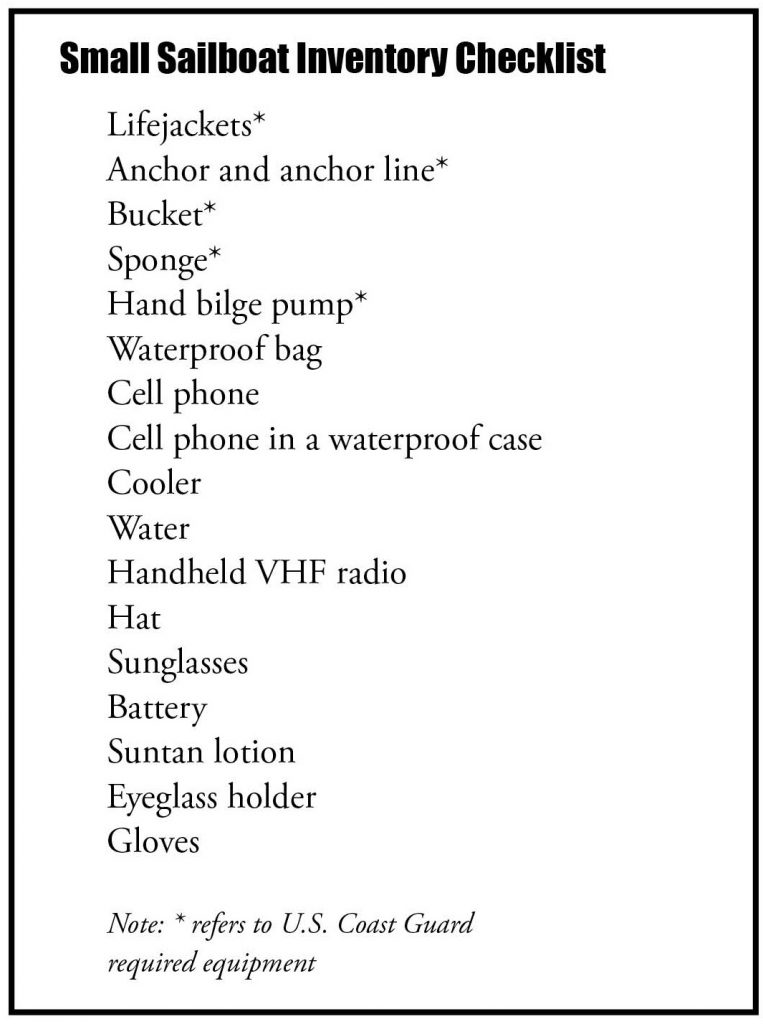
John McCabe is a professional artist with a focus on portraiture (www.mccabestudio.com). He has studios in Milford, CT and Great Falls, VA. He and his wife, Peggy, have four children and seven grandchildren. They all sail out of Milford Harbor.
Share this:
Previous article, next article, leave a reply cancel reply.
You must be logged in to post a comment.


IMAGES
COMMENTS
BoatUS Magazine senior editor Rich Armstrong shows you how to load a boat on a trailer by yourself. It's a bit tricky to get your boat out of the water solo,...
Mount the boat on the trailer without a hitch . When the boat comes in, stow the hook and center the nose of the boat on the first roller. If the depth allows, the crew member on board will remain engaged in forward gear in order to keep the bow in place. All to the maneuver! Winch to tension the cable, until the boat climbs over the first few ...
What's the process when you have your boat hauled from the water for a bit of much-needed maintenance? We take an up-close look at how The Boat Works' haul-o...
Lower the front by pushing the third lever from the left down (it moves the strap the same direction as the lever). Lower the straps until they are about 3 feet underwater and the lowest point. 3. Bring the boat into the well. Drive the boat to the middle of the boat well where the travel lift is.
Once the boat is put back in the water, check the bilges carefully for leaks. Hoses that have been disconnected from thru-hulls have sunk more than one boat. If your boat has a drain plug that was removed when the boat was hauled, make sure that the yard staff know where this is or there may be a delay in getting your boat back into the water.
Daniel Wade. June 15, 2022. Sailboat bottom cleaning is an essential part of regular hull maintenance, but it doesn't have to be a serious hassle. Sailboat bottom cleaning can be done in or out of the water. The most important tools include marine gloves, various scrapers, and brushes. A coat of high-quality bottom paint can reduce cleaning ...
Not all of us can take the time to see the boat come out of the water, but if you can be there, pay attention to two critical areas. Immediately after pressure washing, the bottom will be clean and wet. Before the bottom dries, take advantage of the shiny, wet surface to look for blisters. Look along the hull (not from the side) so that the ...
A railway system uses a cradle on rails to lift your sailboat out of the water onto land. We have seen two of these in south-east Asia (both Thailand) and they seem sturdy. Ultimately, the best method to haul out your sailboat will depend on a variety of factors, including the size and weight of the boat, the location of the haul out facility ...
1) Haul boat out, pressure wash immediately before the hull dries. 2) Block the boat and stage for out-of-water work. 3) Inspect and confirm the work list and original estimate. 4) Negotiate and finalize add-on work found during out-of-water inspection. 5) Begin work on clearances, running gear, propellers.
The first step to confidently boating in shallow waters is understanding your boat's draft. The draft is the depth of water needed for your vessel to float freely without touching the bottom or propellers getting damaged. Make sure to check your boat's owner manual for its draft specifications, and always give your vessel a margin of safety.
Once water is going to the intake ports the boat can then be started. Make sure to verify the water is going to the muffs before starting the engine, this can be verified as water will be leaking out around the muffs. 4. Start the Boats Engine. At this point, once the water is turned on and running to the outboard unit, the boat can be started.
Hurricane Prep 101. A few things you should do when hauling your boat and preparing for a hurricane. Take down all of your canvas—sails, sail covers, biminis, seat cushions, take it all down. Make sure that your boat is watertight, shut all hatches, seal anything that might be leaking. There will be a lot of rain, be ready for it.
Always board near the middle. Unless the captain says otherwise (and gives you a good reason not to), you should always board the boat near the middle. Here the boat rocks the least when you place your weight on it, making it easier to keep balance. 3. Hold on to the shrouds before placing your foot on deck.
Unscrew the deck cap and put the cap in a safe place so you don't drop it overboard. Now, screw the pump out fitting into your waste hole tight enough so that air cannot escape but not so tight that you can't ever get it out. Next, take the ball valve with sight glass and fit it onto the lip of your pump out fitting.
Sharpe pointed out that a mast the size of the Bayesian's is designed for a massive sail, and without that sail raised and catching the wind, the gusts likely would've had a negligible impact on ...
Prepare the trailer. Back on shore, pull the trailer's winch wire or strap out a few feet and hook it to a part of the trailer where it can be easily reached. At the same time, turn the winch handle until it's in a position where you won't have to strain to reach it. 5. Hit reverse.
Practice Tying Knots. For thousands of years, sailors have used times where it is cold or raining by doing things like tying knots. Knots are important on a sailboat and you will need to learn at least some basic sailing knots to sail at all. Sail Safely. At this point, plus practice on the water, you're good to go.
The rigging on your sailboat is important for more ensuring the safety of your boat and its passengers while out on the water. Regularly inspect the rigging for any signs of wear or damage, such as frayed lines or rust on the hardware. If you notice any issues, have them repaired by a professional immediately.
Oct 8, 2016. #1. Looking for ideas on how to pull our boat out of shallow water. Water needs to be about 3ft deep to get onto the trailer, but that's about 15 ft off shore. I was considering loading the trailer 15 ft out then using a vehicle tow rope to pull the boat and trailer close enough to shore, then backup & hitch.
Step 8: Check your Fuel and Oil. Hopefully, you topped off your tank and added fuel stabilizer before you put your boat away for the winter. If you did, you shouldn't have any problems this spring. If you didn't, it's probably best to simply start from scratch, removing any leftover fuel and disposing of it properly.
Superyachts like the Bayesian, which had been available for charters at a rate of $215,000 a week, are designed to stay afloat even as they are taking on water to give the people aboard a chance ...
After 10 minutes we went out to the sea and we saw cushions and all the rest of the boat [that had sunk], and everything which was on the deck, at sea. However, we did not see any people in the ...
Prosecutors said the six passengers were most likely asleep when the boat sank; The probe is now focusing on the crew and their responsibilities, with the captain set to undergo more questioning ...
How do we get fresh water on a sailboat in remote areas and when we're on long passages out to sea? There are actually a few different ways, some easier and...
Only dozens of cushions from the boat's deck and a gigantic radar from its mast floated on the surface of the sea, fishermen said. In all, 22 people were on board, 15 of whom were rescued.
The yacht's mast stood 72.27 meters (237 feet) high above the designated water line, just short of the world's tallest mast which is 75.2 meters, according to Guinness World Records.
When first starting out, you want to gain some experience on the water, learn basic sail trim and navigation, and learn the basic safety rules. You can learn this by taking online courses, and by taking sailing lessons. With the right approach, you could get up to speed in a couple of months and for as little as $500.
When most of the water is out of the boat, a crew member in the water can enter the boat from the stern (not the side), being careful not to tip the boat over again. Wave for help if necessary. Also, if possible, a "Mayday" can be sent on VHF channel 16, monitored by the U.S. Coast Guard, or call 911 on your cell phone. Hopefully, the sail ...
One witness, the owner of a villa looking out to where the Bayesian was anchored, said that after news of the sinking yacht emerged, he watched back his CCTV footage, where the boat could be seen ...
In between the speedboats, luxury yachts, and wooden fishing boats moored in a Hong Kong marina, a different kind of vessel maneuvers. It looks unassuming, but as the three-meter-long (10-foot ...